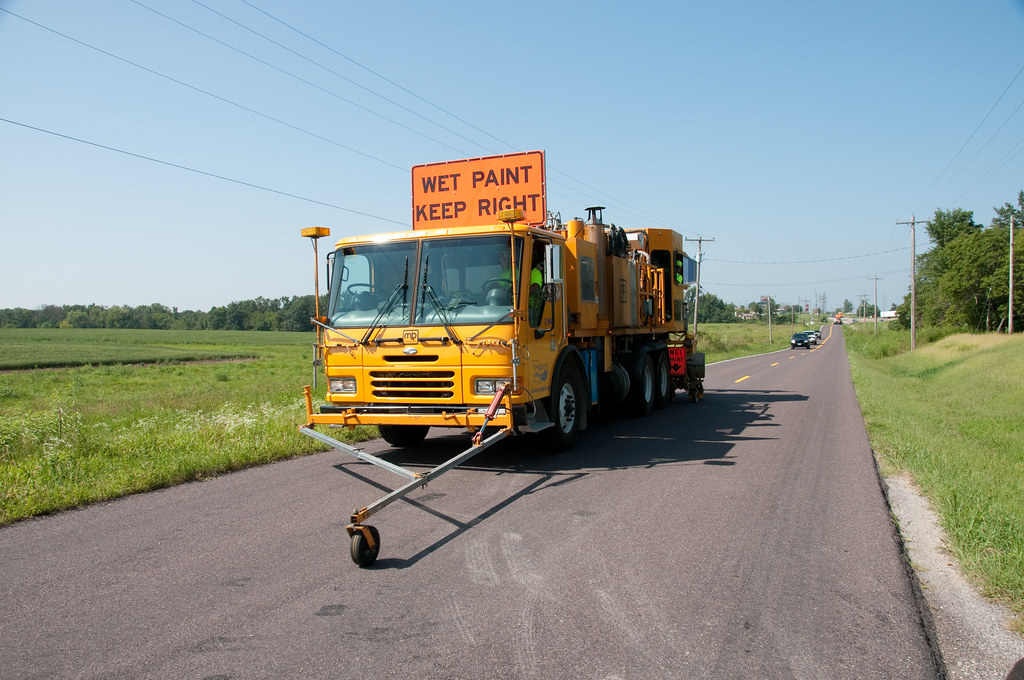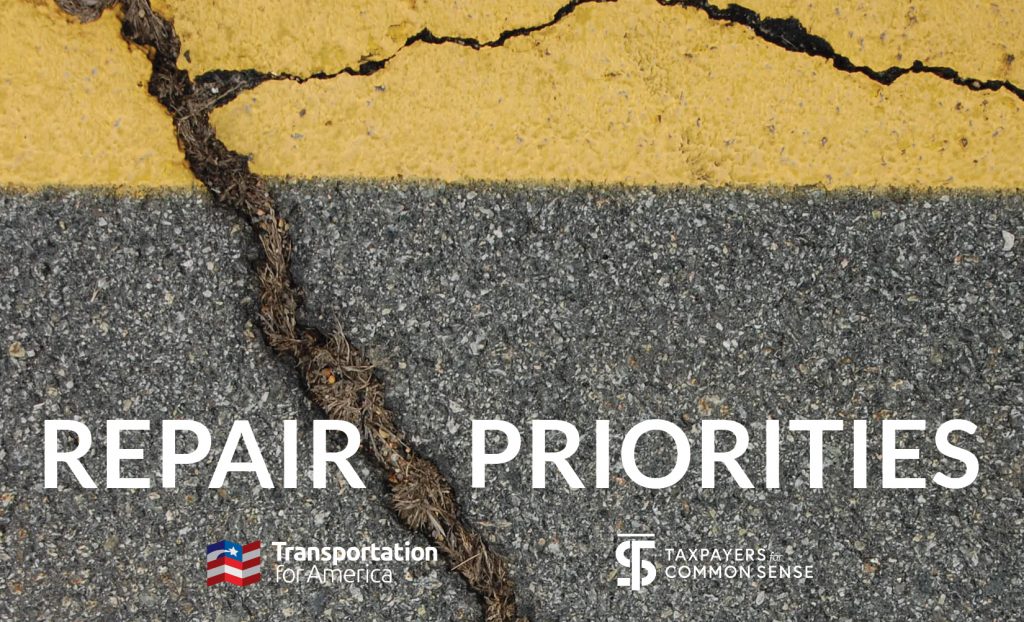On Wednesday, July 10, T4A held a member-exclusive call to discuss the House appropriations bill, the upcoming Senate reauthorization bill and a few other transportation issues in play on the Hill. Here is the slide presentation from that call.
Federal transit funding delays cause real harm
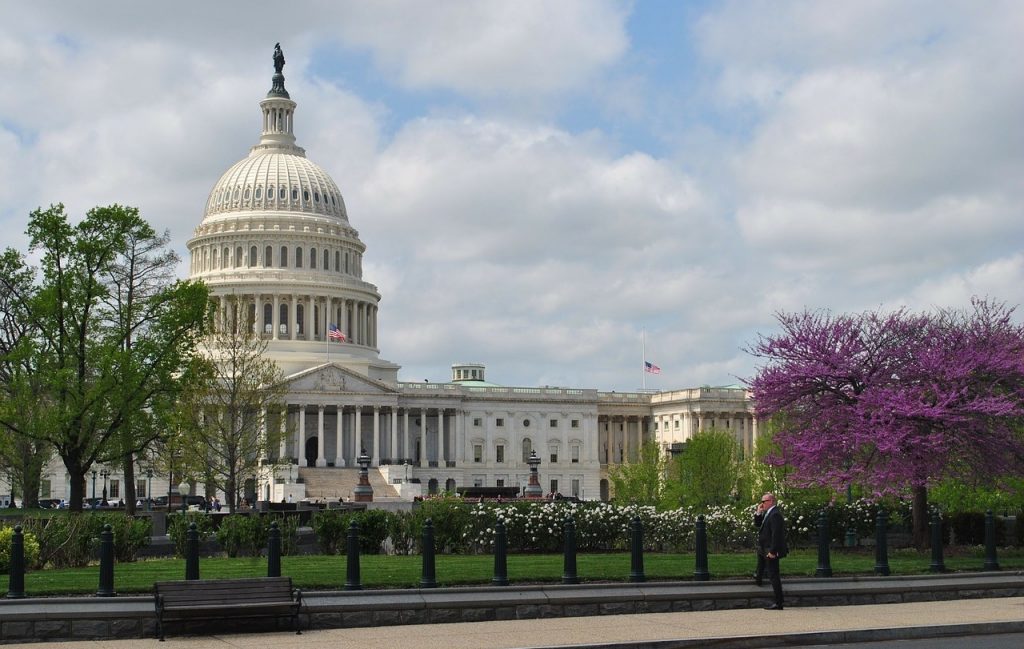
USDOT has been slow-walking federal transit funding since the Trump administration took office and the U.S. House is finally undertaking an oversight hearing to hold them accountable. Here’s a look at one major way USDOT is misleading the public about their lack of progress and some of the impact it’s had on local communities.
Today at 10 a.m., the U.S. House is holding its first oversight hearing on the US Department of Transportation’s (USDOT) efforts to undermine federal transit funding. (Live stream available at the above link.) Since taking office, the administration has inexplicably delayed federal grants for major transit projects, become less responsive, helpful and timely in shepherding projects through the application process, and radically scaled back the amount of information it releases publicly. And the information USDOT does release regarding capital transit grants is often very misleading, designed to make it look like the agency is doing its job when it’s actually not.
Decrypting USDOT
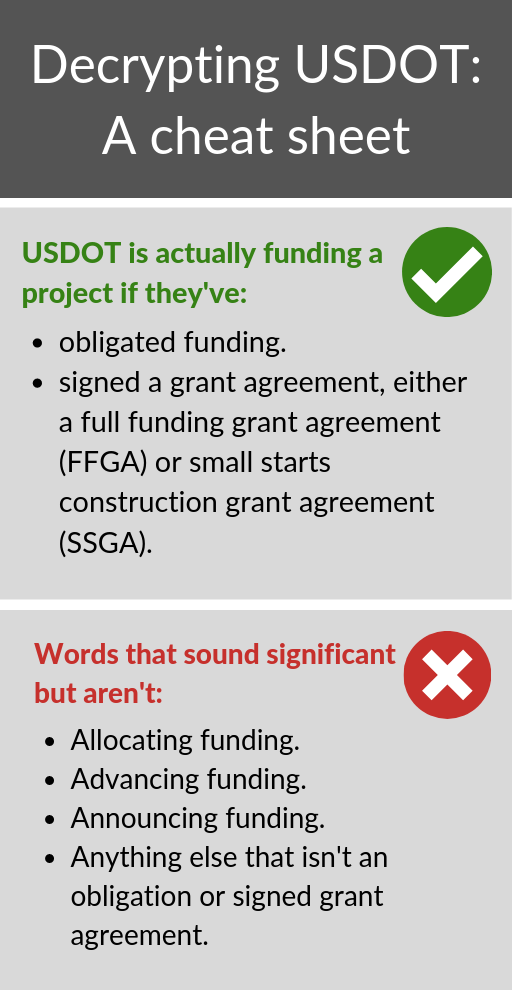 To understand how USDOT is misleading the public it’s important to understand how these capital grant works.
To understand how USDOT is misleading the public it’s important to understand how these capital grant works.
Under previous administrations, USDOT would publish a list of projects it anticipated funding in the following year (it’s a multi-year grant process) and then Congress would fund the program with the requisite amount intended for those projects. As grant applications were tweaked and finalized, USDOT would allocate funding to particular projects before a final grant agreement was signed—which usually happened soon afterward—and money was officially out the door to the project.
Under the current administration, USDOT has stopped publishing a list of projects it anticipates funding next year because they’re ideologically opposed to funding any transit projects. But the transit capital program has bipartisan support and Congress has continued to appropriate funds for it—three times during this administration. Now USDOT—specifically the Federal Transit Administration (FTA) within USDOT—”allocates” funding to projects, they put out a press release lauding their work, newspapers announce USDOT has funded a project (they haven’t), yet no money has changed hands. Getting an “allocation” today just means USDOT moved numbers around on internal spreadsheet, nothing more.
Communities experience real harm
The whole application process is designed to insulate the federal government from losses. Before signing a grant agreement everything has to be in order: local funding must be secured, land acquired, project design finalized, etc. But what happens when communities get their ducks in a row, have put out bids for construction, and then wait…and wait…and wait for a federal agency that doesn’t want to do its job? Materials don’t get less expensive with time (they get more expensive) and bids come with expiration dates; when they expire, the whole bidding process which can take multiple months has to be repeated. While dozens of projects are still waiting for federal funding, here is the impact on three different transit projects, each of which USDOT has “allocated” funds for but which have not received a grant agreement.
The Bay Area
The Transbay Core Capacity Project is a $3.5 billion package of improvements that will help purchase new rail cars for BART and increase capacity in the transbay tube that connects San Francisco and Oakland. According to Railway Age:
BART is ready to move the Transbay Corridor Core Capacity Project into the Engineering phase, and [BART General Manager Grace] Crunican said the agency cannot proceed without FTA funding. She said the project has been delayed by FTA for more than a year, and every year of delay will cost taxpayers an estimated $120 million. BART had been anticipating FTA approval for entry into the Engineering phase by late 2018.
FTA has recently “allocated” $300 million for the Transbay Core Capacity Project from 2018 funds—an unusually high amount—but this does not supply the agency with any funding. Annual grants usually top out at around $100 million (this is a multi-year grant), but FTA has broken with that practice, likely to avoid having to fund other transit projects with the other $200 million.
Los Angeles
The Purple Line Subway Extension, Phase III is the final extension of this subway line that is planned to be completed in time for the 2028 Olympics in Los Angeles. It will connect the Veterans Administration Medical Center and UCLA (which will host the Olympic Village) to the rest of the Los Angeles rail system. According to an editorial in the Los Angeles Times, the LA Metro was up against a clock last year with construction bids set to expire:
The construction bid expires Oct. 3 [2018]. If Metro doesn’t get the funding commitment by then, the agency will have to rebid the contract. That could delay the project by nearly two years and increase the cost by $200 million, Metro officials say.
LA Metro did not receive a construction agreement by October 3, but they did get what’s known as a Letter of No Prejudice (or LONP) just before the deadline that allowed them to begin construction using local funds (and with no guarantee of future federal funding). The project has since received two separate “allocation” of $100 million, one from FY 2018 funding and one from FY 2019 funding. While construction has begun, there is still no funding agreement in place.
Twin Cities
The Southwest Light Rail Extension will extend the Green Line—which connects downtown St. Paul & Minneapolis—from downtown Minneapolis to the southeast suburbs, connecting some major employment centers. After unexplained delays and approaching deadlines, the Star Tribune penned an editorial urging USDOT to act:
The Met Council pleaded for Federal Transit Administration (FTA) action before Sept. 30 [2018], when two key civil contractor bids were set to expire and while sufficient time remained in the current construction season for preliminary work to begin. Those pleas went unheeded, with no explanation. This week, Met Council officials asked bidders for a 45-day extension. Only the low bidder, Lunda/C.S. McCrossan at $799 million, agreed. That leaves Ames/Kraemer, which had bid $812 million, out of contention.
Due to federal delays, Minneapolis was left with only one bidder willing to build its light rail line. But USDOT still failed to act. With only days left before the bid expired—after the extension— Minneapolis received a Letter of No Prejudice and was able to begin construction. Like Los Angeles, there is still no grant agreement in place, which means zero guarantee of federal funding.
These are just three examples of how USDOT is harming communities and undermining their progress on the ground. While many others have experienced similar frustrations and unexplained delays, they are reluctant to speak out publicly for fear of drawing the administration’s ire and further jeopardizing their funding.
These unexpected, unexplained, and unnecessary delays from USDOT are inexcusable and it’s heartening that the U.S. House is holding an oversight hearing. Unfortunately, the hearing won’t feature agency heads from any of those three cities or any other city that has been measurably harmed by these delays. It will feature a representative from the American Public Transportation Association, which represents agencies that must work with the USDOT, a representative from a road builders’ association, and the director of the Kansas City Streetcar Authority, which has not experienced any delays from this administration (yet).
While we’re hopeful that members of Congress will ask probing questions and hold USDOT accountable, the witnesses and their prepared testimony do not inspire confidence.
The House Transportation and Infrastructure Committee is holding an oversight hearing on USDOT’s failure to release transit grants

 House Transportation & Infrastructure Committee Chairman Peter DeFazio (D-OR) speaking at a hearing.
House Transportation & Infrastructure Committee Chairman Peter DeFazio (D-OR) speaking at a hearing.
Transportation for America urges the House of Representatives to turn up the heat on USDOT for failing to release funding for transit grants during an oversight hearing on Tuesday, July 16.
The House Transportation and Infrastructure Committee is holding a long-awaited oversight hearing on Tuesday, July 16 at 10:00 AM to hold the U.S. Department of Transportation (USDOT) accountable for failing to spend transit funds that Congress already appropriated for deserving transit projects.
“The Trump administration is undermining Americans’ access to jobs and improved quality of life by failing to release approved funding for transit projects,” Beth Osborne, director of Transportation for America, said. “USDOT has slowed down the pipeline of projects dramatically and made the process so confusing and unclear that local communities could be discouraged from even applying with their new projects, even though Congress has repeatedly provided funds for this program. Communities and leaders on both sides of the aisle choose to invest in public transit because it makes sense. The federal government needs to do its job—release the funds in a transparent and timely manner.”
Since the Trump administration took office more than two years ago, Congress has appropriated approximately $3.8 billion to the popular transit Capital Investment Grant (CIG) program, the main source of federal funding for building and expanding transit systems in cities of all sizes all over the country.
Congress has continued to hold up their part of the bargain, but USDOT has failed to do its job, awarding just one-third of that $3.8 billion to new transit projects, slowing the pipeline of transit projects down to a snail’s pace. By the middle of 2019—two and a half years into the Trump’s first term—the USDOT had approved and signed just five grant agreements for new, large, multi-year transit projects.
USDOT is still sitting on ~$2.4 billion that is to be obligated to transit projects. Communities are waiting; jobs and critical projects are on the line. Local communities are counting on the federal government to be a reliable partner and provide the funds they have been counting on. The funding for new or improved transit service has already been appropriated by Congress—USDOT just needs to do its job.
Transportation for America applauds Representative Peter DeFazio, chair of the House Transportation and Infrastructure Committee, for bringing this important issue to light. We hope that Committee members will join him in asking difficult questions during the hearing, such as:
- Why does FTA seem to be unwilling to sign grant agreements for eligible transit projects?
- Why isn’t FTA being more transparent and forthcoming about the status of projects publicly and with project sponsors. FTA no longer publishes the same summaries on their website.
- Why does FTA seem to be aiming to confuse the public with the announcements of “funding allocations” which are not binding and don’t result in any actual money going to local agencies?
The Generating Resilient, Environmentally Exceptional National (GREEN) Streets Act introduced in the Senate today

Today Senators Ed Markey (D-MA) and Tom Carper (D-DE) introduced a bill that would measure and reduce greenhouse gas emissions and vehicle miles traveled. This would be transformative.
Transportation is the single largest source of greenhouse gases (GHG), contributing 28 percent of the United States’ total GHG emissions. While many other sectors have improved, transportation is headed in the wrong direction. Driving represents 83 percent of all transportation emissions and these emissions are rising—despite cleaner fuels, more efficient and electric vehicles—because people are driving more and making longer trips.
Unfortunately, our federal transportation program forces people to drive more by measuring success through vehicle speed—not the time it actually takes people to reach their destination. Building wider highways and sprawling cities to accommodate high-speed driving creates a feedback loop of more driving, virtually guaranteeing ever-increasing transportation emissions (and congestion).
To reduce emissions we must make it possible for people to take fewer and shorter car trips, as well as make it easy and convenient for people to bike, walk and use transit. But we can’t do this if we only measure and value high speed car trips. The bill introduced today would change what we measure and value in transportation to include reducing GHG and vehicle miles traveled (VMT).
The Generating Resilient, Environmentally Exceptional National (GREEN) Streets Act, introduced by Senators Ed Markey (D-MA) and Tom Carper (D-DE), will create new performance measures and goals requiring that states measure, and reduce, vehicle miles traveled (VMT) and GHG in their transportation systems.
“To combat climate change, we must reduce emissions and build safer, healthier and more resilient communities,” said Senator Markey, a member of the Environment and Public Works Committee and co-author of the Green New Deal resolution. “That means advancing the goals of clean energy, climate progress, and healthy communities, as well as fortifying ourselves against the adverse impacts of climate change. An essential component of that effort is to re-envision how we plan for, construct, and maintain our federal highway transportation system, using climate measures that matter and hold systems accountable.”
To reduce VMT and GHG, states would likely have to employ a variety of strategies, including better transportation options and smarter land use. These strategies come with a host of benefits besides reducing GHG: reduced congestion, lower household transportation costs, safer streets, more attractive communities and better health outcomes. By measuring how successful transportation projects are by how many destinations—like jobs, schools, and grocery stores— people can access, the federal government can incentivize states and local governments to invest in transit, biking, and walking, as well as build places closer together.
“For decades our federal transportation program has been full of incentives that encourage more driving, longer trips, and more congestion. It’s high time for us to reduce all three of those things as a unifying purpose for the program,” said Beth Osborne, director of Transportation for America. “Doing so will help give Americans more freedom to choose how to get around, save them money, and also reduce the harmful emissions wreaking havoc on our climate. We are hopeful that the GREEN Streets Act will help kickstart an important conversation about finding a new, more productive purpose for the federal transportation program and we are pleased to support it.”
Transportation for America strongly supports the GREEN Streets Act and urges Congress to pass this transformative legislation.
There’s a reason why Missouri voters twice rejected gas tax increases
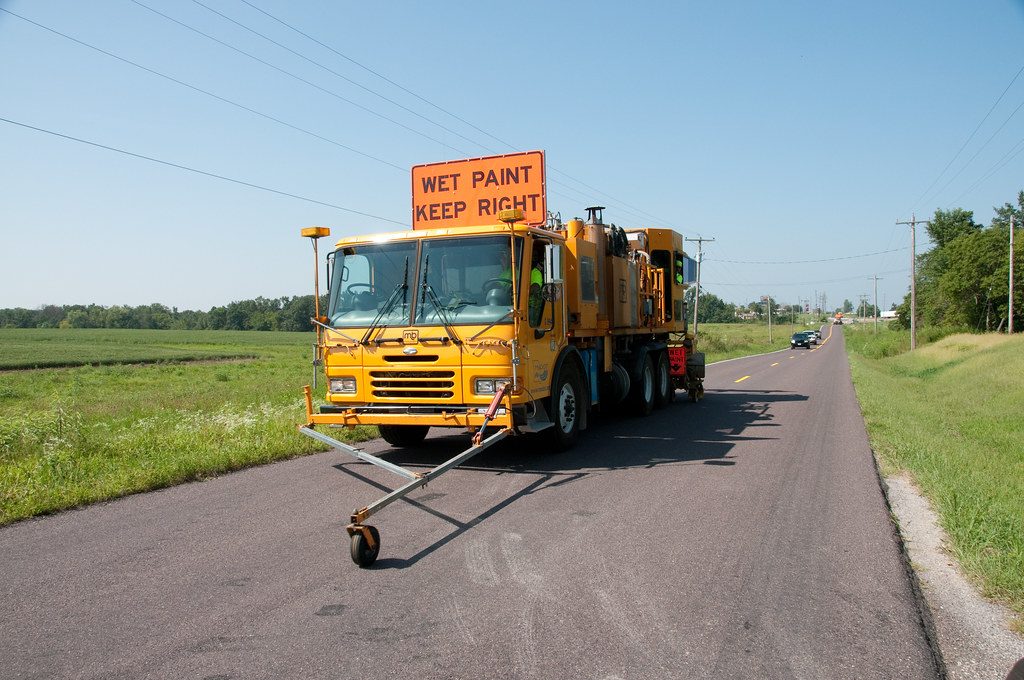
Missouri spends more of its transportation budget on building new roads than maintaining its existing roads—23 percent of which are in poor condition. If it did a better job prioritizing maintenance, perhaps it wouldn’t need to ask taxpayers for a bailout.
The state of Missouri gets over $1 billion a year from the federal government to support their highway needs. They match that with another $1.5 billion in state transportation funding for a total of $2.5 billion in spending a year.
This large sum is what they have to cover the maintenance and upkeep of 77,000 miles of roadway. At ~$24,000 a mile per year to keep a new road in good condition, that means the state has somewhere in the neighborhood of $1.85 billion in baseline maintenance needs for its existing system each year. Of those miles of roadway, 23 percent are in poor condition. (Their repair costs could be much higher: to restore bad roads to good condition costs more than the $24k per lane-mile figure for keeping new roads in good repair.)
The bottom line is that Missouri has a lot of built-in, predictable costs that they need to cover and a pretty deep well of existing transportation funding. But Missouri, along with 20 other states across the country, is actually spending more money on building new roads than on maintaining the ones they already have. According to their own reporting, Missouri is spending 31 percent of their federal funding on new roads while spending only 20 percent on repair of existing roadways. (Note that Missouri’s largest metropolitan area, St. Louis, is heralded for having the least traffic congestion in the country, which makes you wonder why the state feels the need to widen roads.)
After spending more money on expansion than repair, Missouri cries poverty and asks its taxpayers for more money. Perhaps it’s no surprise that voters have said no to them—twice. Should a bank loan you money to expand your deck while your roof is leaking?
Now the state is selling bonds to cover the cost of replacing rural bridges—an important investment. But one has to wonder, how many bridges and roads could they have already replaced with existing funds if those funds were prioritized to maintaining existing infrastructure before building the next shiny new highway or adding more lanes somewhere? At the very least, shouldn’t taxpayers expect as much money to go into highway maintenance as into expansion?
Unfortunately, neglecting repair while spending more money on building new roads is perfectly legal and permissible under the federal transportation program. Congress is just fine with Missouri neglecting needed repairs and increasing their overall need by adding more lanes, and as a result, Missouri is not alone.
This lack of accountability and clear priorities is why Missouri’s roads—and other roads, bridges, and transit systems in poor condition across the country—won’t be fixed by simply spending more money. In spite of unprecedented high levels of transportation funding, including from the Recovery Act, roadway conditions nationally have deteriorated over the last 10 years. Even if we double nationwide transportation spending, there is no guarantee that roads will improve in Missouri or elsewhere without a change to the underlying policies. This is why every conversation about transportation policy that begins and ends with money just isn’t good enough right now.
Missouri is fortunate to have powerful members of Congress that are uniquely positioned to change and improve policy. We can require states receiving federal money to maintain roads before building new ones. They could also require it of themselves.
Prioritizing repair is common sense. We cannot afford to waste any more time and money.
Read more about Missouri and 20 other states making the same mistake in our report Repair Priorities.
Announcing our inaugural Arts, Culture and Transportation Fellows

 Top left across to bottom right: Keiko Budech (WA), Cecelia DeLeon (WA), Katherine Gregor (TX), Sue Lambe (TX), Danicia Malone (IN), Jackie Nirenberg (TX), Jessica Ann Ramirez (WA), Antony Ramos (AR), Brittanie Redd (IN), Shann Thomas (WA), Erika Wilhite (AR).
Top left across to bottom right: Keiko Budech (WA), Cecelia DeLeon (WA), Katherine Gregor (TX), Sue Lambe (TX), Danicia Malone (IN), Jackie Nirenberg (TX), Jessica Ann Ramirez (WA), Antony Ramos (AR), Brittanie Redd (IN), Shann Thomas (WA), Erika Wilhite (AR).
Transportation for America announces its inaugural class of fellows for the new Arts, Culture and Transportation Fellowship to help 11 individuals in four cities take their work at the intersection of arts and transportation to the next level.
Transportation for America is excited to announce the fellows for its first Arts, Culture, and Transportation (ACT) Fellowship. Eleven fellows will represent four cities from around the country. The fellows are:
- Keiko Budech, Communications Manager, Transportation Choices Coalition (Seattle/Puget Sound, WA)
- Cecelia DeLeon, Visual Artist and Teaching Artist (Seattle/Puget Sound, WA)
- Katherine Gregor, Principal, Katherine Gregor Communications / Communications, Austin Transportation Department (Austin, TX)
- Sue Lambe, Manager, City of Austin Art in Public Places Program, City of Austin (Austin, TX)
- Danicia Monét Malone, Urban Planner, Programs & Facilities Manager, Purdue Black Cultural Center (West Lafayette, IN and Indianapolis, IN)
- Jackie Nirenberg, Community Engagement Manager, Capital Metropolitan Transportation Authority (Austin, TX)
- Jessica Ramirez, Director of Community Engagement, Puget Sound Sage (Seattle/Puget Sound, WA)
- Antony Ramos, Director of Digital Marketing, Fruit of Business (Springdale, AR)
- Brittanie Redd, Principal Planner for Land Use Strategy, Department of Metropolitan Development (Indianapolis, IN)
- Shann Thomas, Visual Artist and Teaching Artist: Film & Photography (Seattle/Puget Sound, WA)
- Erika Wilhite, Artistic Director, En Masse Arts (Springdale, AR)
About the ACT Fellowship
The ACT Fellowship is a new opportunity for professionals to increase their knowledge of the transportation planning and design process while developing creative placemaking skills to better integrate artistic and cultural practices in transportation projects. With generous funding from the Kresge Foundation, T4America will provide hands-on, curated learning opportunities. T4America and SGA staff, as well as a team of national experts, will educate fellows on best practices, while fellows will have an opportunity to share their own challenges and learn from one another.
“Transportation for America’s arts & culture team has supported the integration of artists and the arts into transportation projects around the country for the past three years. We’re thrilled to now move into the next phase of this work with the launch of our inaugural class of Arts, Culture, and Transportation Fellows,” explains Ben Stone, director of arts & culture for Smart Growth America. “These fellows include artists, planners, arts administrators, and advocates representing some of the country’s most innovative organizations and agencies, and I look forward to supporting their work, providing an opportunity for them to learn from one another, as well as to learn from each of them.”
The fellowship is also designed to cultivate new national leaders in this arena. After the fellowship concludes, several graduating fellows will be offered the opportunity to assist with the next round of T4America’s State of the Art (SOTA) Transportation Trainings in communities across the country. By serving as consultants on these trainings, participating fellows will have the opportunity to develop new leadership, facilitation, and presentation skills.
About the fellows
Seattle/Puget Sound, Washington: The four-person team of Keiko Budech, Cecelia DeLeon, Jessica Ramirez, and Shann Thomas aims to co-create artworks at new light rail stations to create new community hubs that will preserve and celebrate each neighborhood’s history and culture in the Seattle/Puget Sound area. With the passage of Sound Transit 3, a ballot initiative that is raising $54 billion for light rail expansion and the most significant transit expansion package in Washington State history, this is an exciting opportunity for this group of fellows to undertake an arts, culture, and transportation project and gain skills to execute this work.
Austin, Texas: Sue Lambe, Jackie Nirenberg, and Katherine Gregor will work together to capitalize on the momentum of Capital Metro and the City of Austin’s Art in Public Places (AIPP) program. Capital Metro, Austin’s regional public transportation provider, is in the process of launching an art program that the team will work to formalize through new policies and processes. The AIPP program also has a new, historic opportunity to create public art projects on major streets through a percent-for-art program and the current $482 million Corridor Improvement Program.
Springdale, Arkansas: The duo of Antony Ramos and Erika Wilhite will incubate their project En Route, a creative placemaking initiative on buses and along bus routes in Springdale. Their work will center the perspectives and stories of the people who will be most impacted by transit development in Springdale. They hope to inform Connect Northwest Arkansas, a 10-year transit development plan that will create a blueprint for improving and expanding transit in the Northwest Arkansas region.
Indianapolis, Indiana: Danicia Monét Malone and Brittanie Redd are undertaking a tactical urbanism and equitable design initiative called #MyRide. This emancipatory data/design project will address a bus rapid transit development corridor in Indianapolis, directly confronting infrastructure changes, challenges, and concerns around how details are translated to residents.
The fellowship is generously funded by the Kresge Foundation, which defines creative placemaking as an approach to community development and urban planning that integrates arts, culture, and community-engaged design strategies to expand opportunities for low-income people in disinvested communities in American cities.
CONTACT: Steve Davis, sdavis@smartgrowthamerica.org / 202.971.3902
For resources on how arts can improve transportation projects, check out our Creative Placemaking Field Scan, which identifies seven trends and best practices.
Letter urges lawmakers to fully fund transportation this year and rethink the federal transportation program

WASHINGTON, DC – With over 200 signatures from elected officials and organizations,
Transportation for America today sent a letter to Congress calling for Members to use fiscal year
2020 appropriations and the upcoming surface transportation reauthorization as two opportunities
to fundamentally change the federal transportation program.
Transportation for America (T4America) urges Congress to fully fund critical transit, passenger rail
and multimodal programs at historic and/or FAST Act authorized levels this year and to set a vision for
the next reauthorization, including holding the program accountable for maintaining our
transportation system, building safer streets, and connecting people to jobs and services by providing
reliable transportation choices.
“We can no longer afford to keep doing the same thing when it comes to our broken federal
transportation policy,” said Beth Osborne, Director of Transportation for America. “With several
potential opportunities ahead—FY20 appropriations, the looming surface transportation
reauthorization, or an infrastructure package— it’s vital that Congress recognize that new funding
alone will not solve our problems. We are asking Congress to reset our priorities, like prioritizing the
repair and maintenance of our existing roads before allowing states to build expensive new ones that
also bring decades of new repair costs. We are asking Congress to invest in providing more
transportation choices and to measure transportation success the way normal people do: by
measuring what destinations they can reach quickly, safely, and affordably, rather than by just
measuring how fast vehicles are traveling. We are urging Congress to prioritize safety and equity by
embedding these values in our system. And we are urging Congress to harness the power of
technology as a means to achieve these goals and prevent it from exacerbating our problems. These
are achievable shifts that would make a huge, positive difference in people’s lives across the country.”
The letter also asks that the surface transportation reauthorization do more to provide people with
real transportation options—rather than just driving—by investing in transit, biking and walking. And
that it ensures that local entities are allowed to regulate new technologies, such as autonomous
vehicles and electric scooters, focuses on elevating communities of color and low-income
communities that have been disproportionately harmed by past transportation investments, and
prioritizes safety over vehicle speed when designing roads.
Regarding fiscal year 2020 appropriations, T4America specifically asks that Congress fund the transit
Capital Investments Grants (CIG) program, the Better Utilizing Investments to Leverage
Development (BUILD, formerly known as TIGER) program, the Consolidated Rail Infrastructure and
Safety Improvements (CRISI) program for passenger rail at or above the authorized levels; and take
legislative action to keep the mass transit account of the Highway Trust Fund solvent. These locally
driven programs provide communities with resources to invest in important transportation
infrastructure and operations that are otherwise difficult to fund.
The full letter with the list of all 200+ signatories spanning 40 states and including 50 elected
officials can be found here.
A major obstacle cleared for bringing new passenger rail service to the Deep South
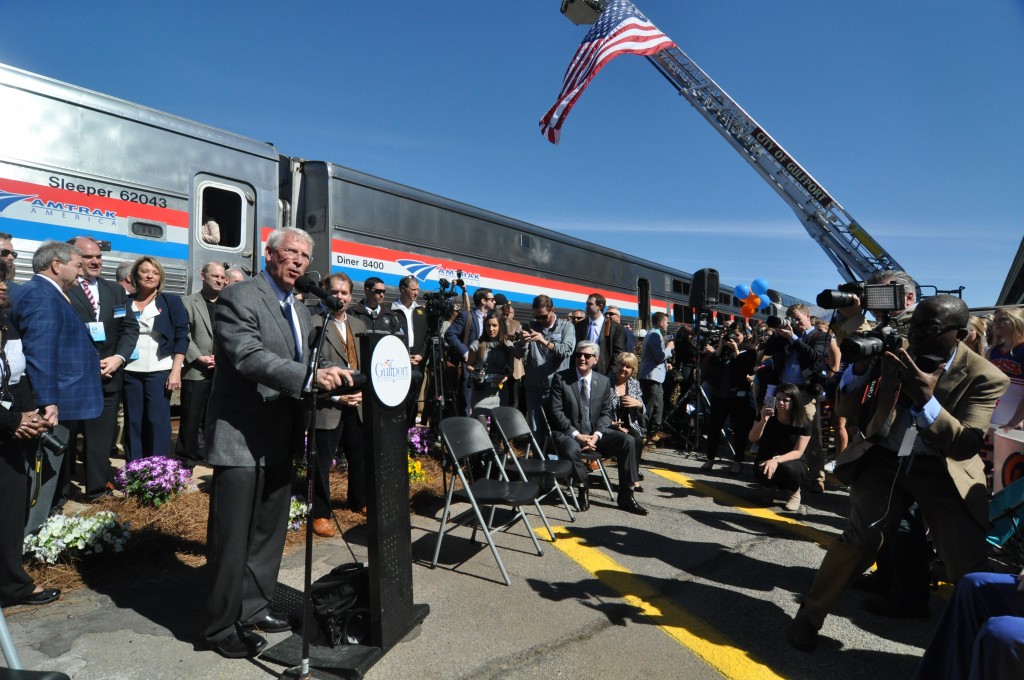
Almost 14 years since Hurricane Katrina wiped it out, passenger rail service along the Gulf Coast is closer than ever to returning after a vital federal grant was awarded to help fund the capital investments required to bring new and drastically improved passenger rail service back between New Orleans and Mobile, AL, and Transportation for America played a major role.

Sen. Roger Wicker (R-MS) addresses the enormous crowd in Gulfport on the second stop of the Gulf Coast inspection train in 2016. Photo by Steve Davis / T4America
“We’ve got the top brass, we’ve got the local leaders, and we’re gonna make this work for Mississippi and for the taxpayers,” Mississippi Senator Roger Wicker told a crowd of a thousand or more fired-up Gulfport residents over three years ago in front of the city’s historic train depot in the middle of town. And Senator Wicker has kept his promise.
That crowd—and more than a dozen just like it in communities from New Orleans to Jacksonville—turned out in massive numbers in February 2016 to see an Amtrak passenger train roll through for the first time since Katrina darkened those shores in August 2005. They also showed up to send a clear and powerful message to their elected leaders. As I wrote back in 2016 from the train, “Rich people, poor people, black people, white people, young people, old people — all asking their elected leaders for the same thing: We want passenger rail back on the Gulf Coast.”
With this week’s announcement of a $33 million federal grant, communities across the coast can make the capital improvements necessary for running passenger trains throughout the corridor owned by CSX. The grant will be matched with commitments from the state of Mississippi, the Mississippi Department of Transportation, Amtrak, and private partners, and is paired with priority investments from the state of Louisiana. When it does start up, this new service will be like an iPhone compared to a 2000s-era flip phone. Cities along the route can expect business friendly service on four trains a day, running in daytime hours and on time, with food, drink and hospitality designed to reflect the unique culture of the region.
Thanks to this historic award, the thousands of residents who turned up in force to show their support for passenger rail could be less than 24 months from being able to finally hear “Y’all Aboard!!”
A bipartisan coalition of local leaders, mayors, business people, governors, and their representatives in Congress are close to creating what would be the first new long-distance passenger rail service in the U.S. in more than half a century—and it’s in the Deep South. How did this happen, and what should it mean for other similar corridors across the country?
New passenger rail service in the Deep South — how did it happen?
It never would have happened without the day-in, day-out work of the Southern Rail Commission, a Congressionally established tri-state rail compact—the only one of its kind—with members appointed by the governors of Louisiana, Alabama and Mississippi. Essentially inactive and idle a decade ago, the SRC was reconstituted and has been the driving force, bringing together local mayors along the line, building support amongst business leaders in the region, and garnering the support of their governors and elected leaders in Congress.1
With the SRC driving the project forward with the public and within the states, they needed a champion in Congress, and they found one in Senator Roger Wicker, who has done everything possible to keep his promise made in Gulfport that day in 2016. With the help of Senator Cory Booker, the Senators drafted a provision (included in the FAST Act) that created the Gulf Coast Working Group to study the restoration of passenger rail service. Later that year, those Senators, with incredible support from the late Mississippi Senator Thad Cochran, ensured that the omnibus budget bill provided the funding to start the working group. And Senators Cochran, Richard Shelby (AL), and Cindy Hyde-Smith (MS) were also instrumental in appropriating funding for the new federal programs to make capital and operations grants to help expand passenger rail service.
“Everyone needed to see a train again”
For 11 years after Katrina, even after a mammoth five-month rebuilding effort along the CSX-owned freight rail line to restore freight service, no passenger trains ran east of New Orleans. With even the vague memory of the previous subpar and regularly delayed passenger service receding into distant memory for many residents, everyone needed to see a train again.
So back in 2016, the SRC partnered with Amtrak to run a special inspection train from New Orleans to Jacksonville, Florida. While there were some technical necessities for this trip—Amtrak inspected the tracks and stations to determine what physical needs there were along the line—the most important function was filling that train with elected, civic and other local leaders from the Gulf Coast and providing a visible sign for residents to rally around.
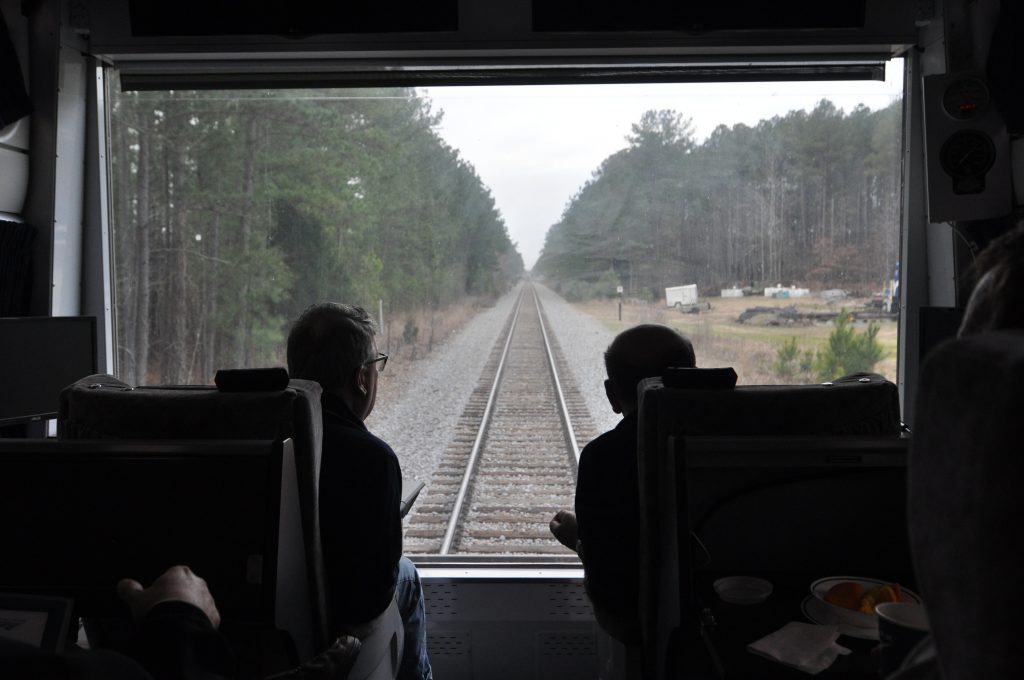
I was on that train, and I will never forget the moment we rolled into Bay St. Louis, MS for the first stop after departing New Orleans. Conversations halted immediately on the train as we were taken aback by the overwhelming sights and sounds of Bay St. Louis. Schools were closed, bands were playing, costumes were donned, and it seemed like the entire city had turned out to see the first passenger train in 11 years.

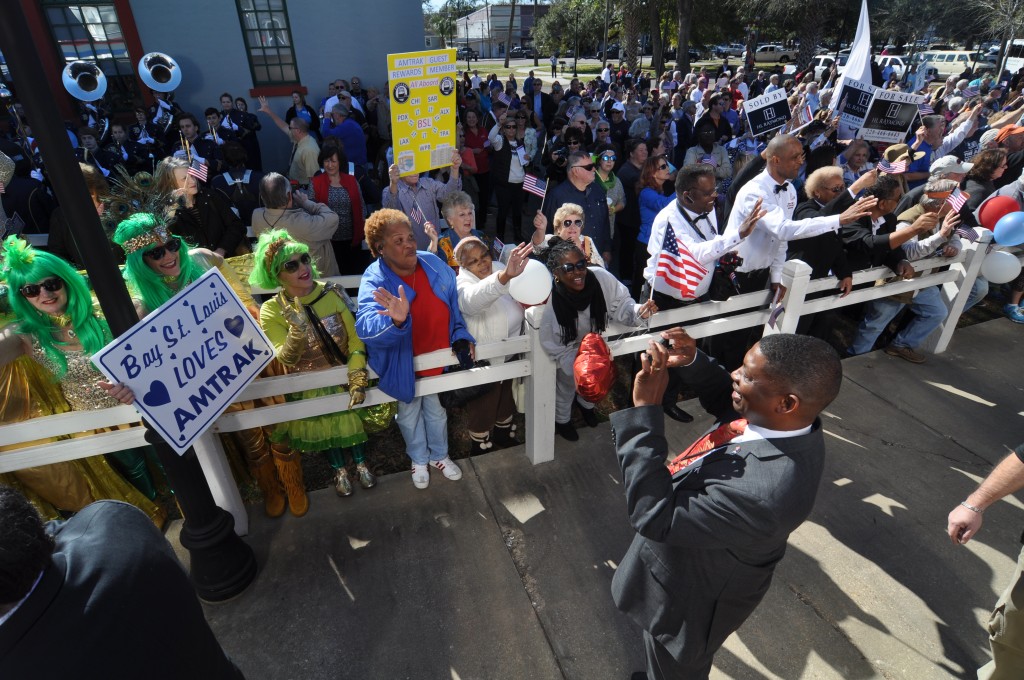
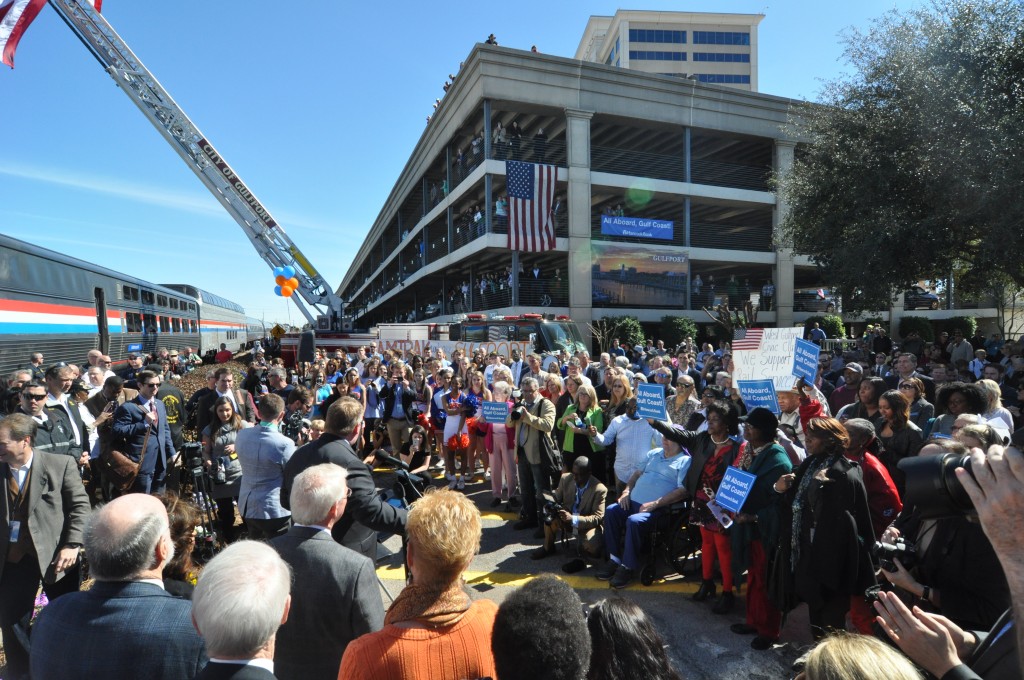
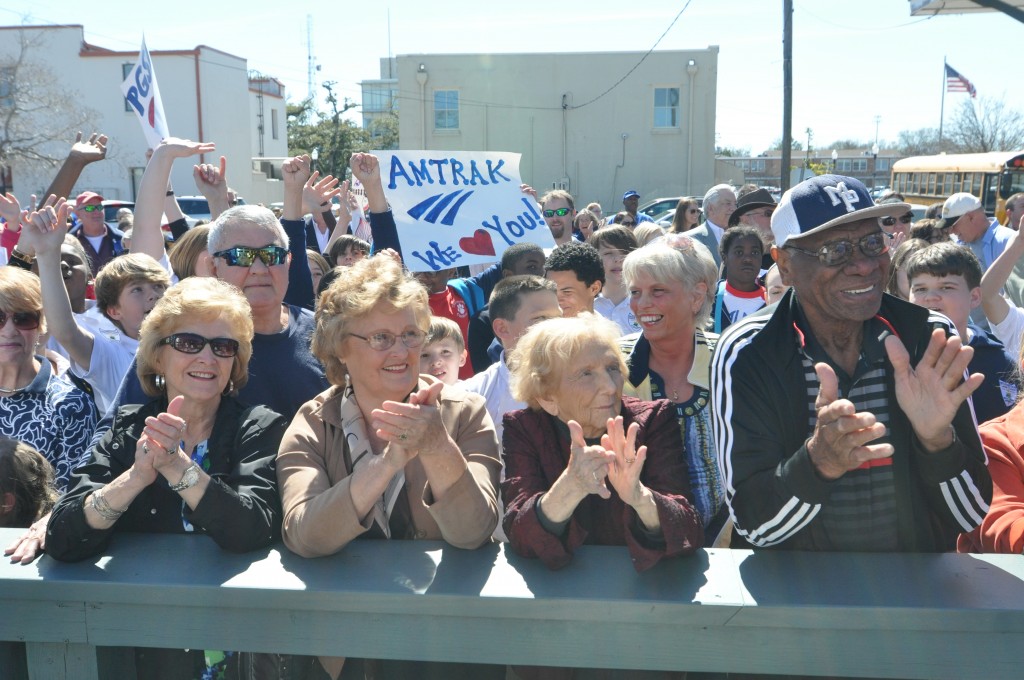
John Sharp, writing for AL.com, summed things up well, describing the arrival of that train as an incredibly cathartic moment for a city that was devastated by Hurricane Katrina and had fought for years to bounce back. Bay St. Louis wasn’t an outlier, though. That scene was repeated in town after town, whether in Mississippi’s second largest city of Gulfport, or tiny little Atmore, AL:
It was an incredible sight to see, and it had a palpable, powerful effect on the elected officials and VIPs from Washington on board. None of them will be able to go back to work in their government offices without thinking of the faces of the people they saw on this trip and how excited they were about the prospect of seeing this vital connection restored.
That’s precisely what happened, and the evidence can be found in the state money that Louisiana Gov. John Bel Edwards and Mississippi Gov. Phil Bryant (with the full backing and support of the Mississippi DOT and commissioner Dick Hall) committed to the project before they had a dime of federal money in hand.
Watch our short video chronicling the two-day Gulf Coast inspection train in 2016.
What’s the next step to get trains running again?
With this $33 million federal grant from the Consolidated Rail and Infrastructure Safety Improvements program (CRISI) in hand, work should begin quickly on the capital upgrades to rails, ties, stations, and the other infrastructure required to run reliable passenger trains in the corridor. Amtrak and the SRC are committed to bringing back new, reliable, regular, daytime passenger service within 24 months from now—service that will be far better than what was eliminated in 2005.
Amtrak will also begin negotiations with CSX for use of the right-of-way which CSX must allow by federal law. T4America and SRC are anticipating productive negotiations with the private railroad, but a landmark Supreme Court decision just last week upholds last year’s decision to allow the Federal Railroad Administration (FRA) and Amtrak to set on-time performance standards, a crucial measure to increase the reliability of passenger rail service; a decision that will also strengthen their position in negotiations.
“This ruling opens the door to fixing one of the main issues with our passenger rail system,” said John Spain, Chairman of the Southern Rail Commission. “Increasing on-time performance will increase the reliability of and trust in the system, and now Amtrak can finally take steps to do this.
This story shouldn’t end on the Gulf Coast

While Transportation for America is delighted to see the progress toward returning passenger rail service to the Gulf Coast, new trains running between beautiful Gulf Coast cities should be the blueprint for other corridors to do the same all across the country.
“All of this should also send a powerful message to Congress and to Amtrak’s board that this country absolutely needs a thriving system of long-distance and shorter-corridor passenger rail service that works together to form a national network,” said T4America chair Mayor John Robert Smith, former board chairman of Amtrak, who was also responsible for building the first new multi-modal station in the south during his long tenure as Mayor of Meridian, MS.
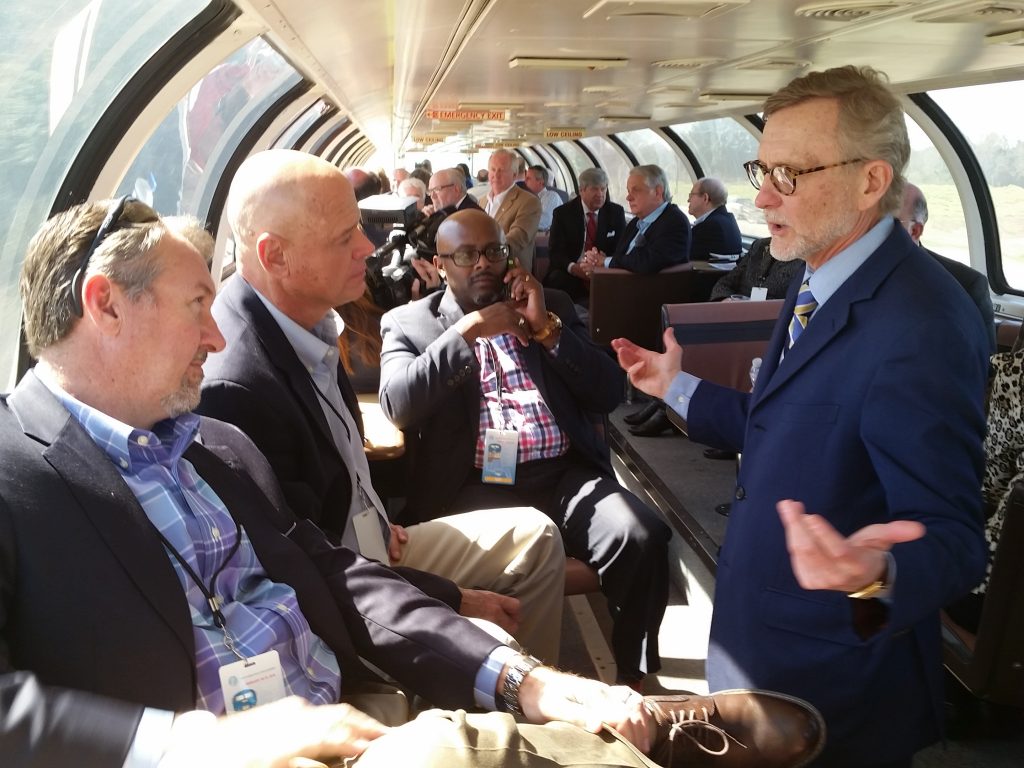
There’s already movement afoot to start new service between the twin economic centers of Baton Rouge and New Orleans in Louisiana, and along the I-20 corridor between Meridian, MS and Shreveport, LA. This comes in addition to longstanding conversations to protect and expand service in the Midwest, the Mountain West, the Pacific Northwest, and across the country.
I spent three days on this train interviewing and chatting with local elected officials from communities all along the coast who explained to me how it was essential to their economic development and quality-of-life efforts to bring passenger rail service back.
One of my favorite characters I met was Mayor Knox Ross, the mayor of Pelahatchie, MS and an SRC Commissioner. A few days after the trip, he came up to Washington to share his story with the Senate Commerce Committee and explain how this passenger rail connection would be a powerful economic development tool for these Gulf Coast cities, small and large:
“We invested in the national interstate system years ago and saw tremendous economic development, but now we’re having to put more money than ever into it with diminishing returns as we add lanes. Every modest investment in passenger trains across this country can create large economic development opportunities in all these cities. …We saw an amazing outpouring of support in every city. …They just want an opportunity. Every city turned out. They’re looking for a hand up and saw Amtrak service as that opportunity.”
We’re proud to celebrate this monumental event for the Gulf Coast and will continue counting down the days until those thousands of people we met there can hop a train and travel the Gulf Coast with a reliable new mode of travel.
“Y’all Aboard!”
All photos by Stephen Lee Davis / Transportation for America
Gulf Coast passenger rail receives $33 million in federal funding
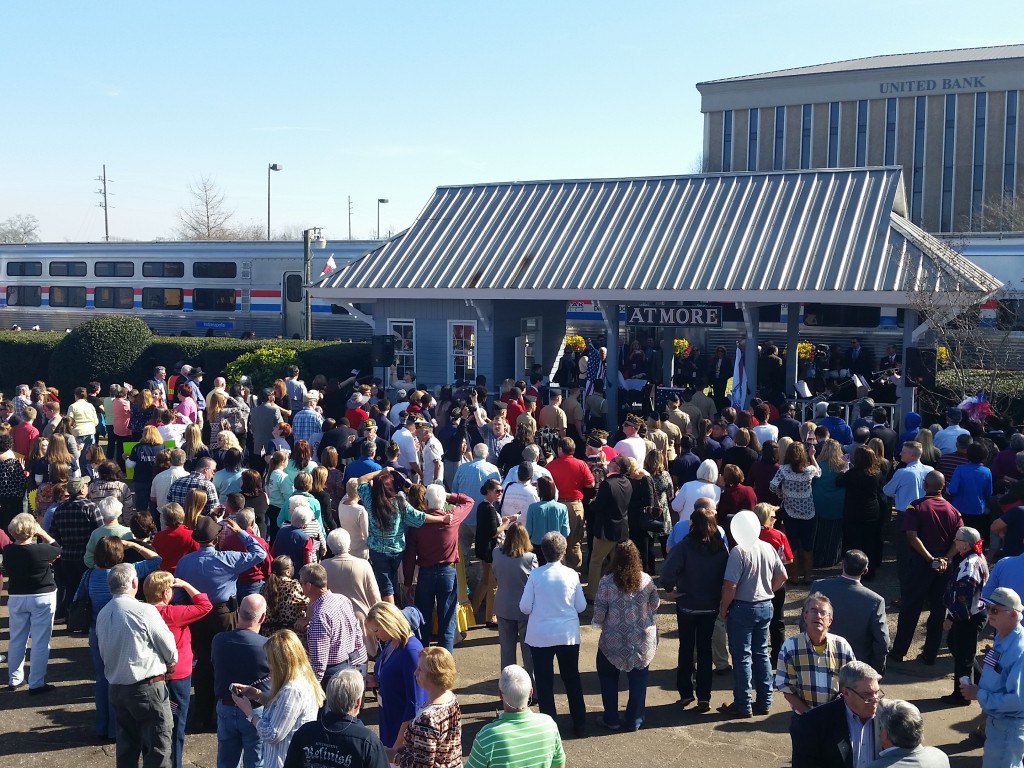
New Orleans to Mobile passenger service gets a boost
BATON ROUGE, LA, June 7, 2019 — The Southern Rail Commission’s efforts to restore passenger rail service to the Gulf Coast received a significant shot in the arm Friday with the long-awaited announcement of a $33 million grant from the Federal Rail Administration (FRA). This federal grant will be matched with commitments from the state of Mississippi, the Mississippi Department of Transportation, the city of Mobile, Amtrak, and private partners, and is paired with priority investments from the state of Louisiana. Combined, this funding will be used to make the major infrastructure and capital investments required to allow Amtrak to move ahead with launching new, regular, reliable passenger service between New Orleans, LA and Mobile, AL.
The Southern Rail Commission (SRC), which applied for the grant from the federal Consolidated Rail Infrastructure and Safety Improvements (CRISI) program, has been steadfastly committed to restoring the Gulf Coast passenger rail service that stopped nearly 14 years ago when Hurricane Katrina devastated rail infrastructure along the coast. This has been and continues to be a bipartisan effort of the Louisiana, Mississippi, and Alabama SRC commissioners, the populace of the states, Gov. Phil Bryant and Gov. John Bel Edwards, and Congress.
Commissioner Knox Ross of Mississippi praised his state’s leadership in this effort, saying, “We would never be this close to seeing trains run again without the strong support of Mississippi Senator Roger Wicker and his hard work to authorize the necessary programs and supply them with funding. I also want to recognize the contributions of the late Senator Thad Cochran for his repeated appropriations support for these programs. And Governor Phil Bryant fulfilled his promise to the people of Mississippi by committing significant state funds to the project, backed with the full support and funding of the Mississippi DOT, led by commissioner Dick Hall.”
Chairman John Spain recognized Louisiana’s investment in the project, noting that, “Governor John Bel Edwards, with strong support from DOTD Secretary Shawn Wilson, made the necessarily financial commitments for the infrastructure desperately needed in Louisiana to restore service. And we never would have been able to navigate these complex issues in Washington, DC without the policy guidance and hard work of our colleagues at Transportation for America.”
Thanks to work from Senators Wicker and Cory Booker (NJ), Congress created the Gulf Coast Working Group in the 2015 federal transportation reauthorization (the FAST Act) to perform an exhaustive study on restoring the service, which was administered by the FRA. The FRA and the US Department of Transportation, including Secretary Elaine Chao, are to be praised for their work to advance this vital project.
Finally, Amtrak has also showed a consistent commitment to the project, providing an inspection train in 2016, working to minimize freight conflict, and contributing matching funds for the grant application. “Amtrak has strong state and local partners in Mississippi, Alabama, and Louisiana,” said Amtrak President Richard H. Anderson. “The Mobile-New Orleans route exemplifies the type of short corridor service Amtrak wants to establish throughout the nation.”
“As the inspection train rolled through scores of communities back in 2016, we were overwhelmed at the thousands of people who turned out in every stop to make it clear that they urgently want passenger rail service back in their communities,” said John Robert Smith, chair of Transportation for America, former mayor of Meridian, MS and former chair of the board of Amtrak. “They understood that new rail service would be a win for the economy, for tourism, for local business, and for all of their residents who get a new affordable way to travel the region. We’re hopeful that Congress also gets the clear message that they should be aiming to replicate this kind of story in other corridors all across the country as they maintain a vital national passenger rail network.”
This new passenger rail will serve the coastal south in a more robust way than the old service ever did, stopping four times a day in New Orleans, Bay St. Louis, Gulfport, Biloxi, and Pascagoula with business-friendly, daytime service. It will link visitors, employees and state residents to Gulf casinos, military bases, historic sites, tourist attractions, and colleges. These capital investments will not only benefit passenger traffic, but freight as well, and the SRC is committed to supporting port access and circulation. According to the Trent Lott National Center for Excellence in Economic Development and Entrepreneurship at the University of Southern Mississippi, the passenger rail will generate $282.58 million annually in the State of Mississippi, and will create 45 new full-time, permanent, high-wage train operating jobs in Louisiana. The impacts on tourism could be even more dramatic, as the study found that just a modest five percent increase in visitors in Harrison County (MS) could generate $92 million more in spending and income annually. The SRC hopes Alabama will come to the table with matching funds for the next grant cycle so passenger rail can be extended to downtown Mobile.
The $33 million grant from the FRA comes from the Consolidated Rail Infrastructure and Safety Improvements (CRISI) Program.
With these long-awaited grant funds awarded, the SRC, Louisiana, Mississippi, and Amtrak intend to move quickly and have trains running in 24 months, anticipating productive negotiations with CSX as Amtrak works with the private railroad to clear the way for space for passenger service. They’ll do so with the support of a landmark Supreme Court decision made earlier this week that will allow the Federal Railroad Administration (FRA) and Amtrak to finally set on-time performance standards and increase the reliability of passenger rail service.
Senator Wicker and his staff helped organize the inspection train in 2016 and worked for the past four years to get the CRISI funding. SRC thanks the late Senator Cochran for helping to get these grant programs funded, and Senators Shelby and Hyde-Smith for supporting the appropriations. The SRC further applauds the support of the congressional delegations from Louisiana, Mississippi, and Alabama for their support of Gulf Coast passenger rail. The SRC commissioners commend Transportation for America, Center for Planning Excellence, and DSD Services Group for helping to support this effort.
“The SRC encourages Members of Congress to continue to support and expand the CRISI and Restoration & Enhancement Grant programs for the benefit of our three States and the nation. These programs would support additional priorities including restoring passenger rail service between Baton Rouge and New Orleans, Meridian and Dallas Fort Worth, and Mobile, Montgomery, and Birmingham.”
###
About the Southern Rail Commission
Created by Congress in 1982, the Southern Rail Commission (SRC) was designed to engage and inform public and private rail interests to support and influence Southeast rail initiatives. The SRC is led by governor-appointed commissioners from Alabama, Mississippi, and Louisiana, and promotes the safe, reliable and efficient movement of people and goods to enhance economic development along rail corridors; provides transportation choices; and facilitates emergency evacuation routes.
About Transportation for America
Transportation for America is an alliance of elected, business, and civic leaders from communities across the country, united to ensure that states and the federal government step up to invest in smart, homegrown, locally-driven transportation solutions — because these are the investments that hold the key to our future economic prosperity. T4America is a program of Smart Growth America. www.t4america.org
Try as Trump might, transit grants are here to stay
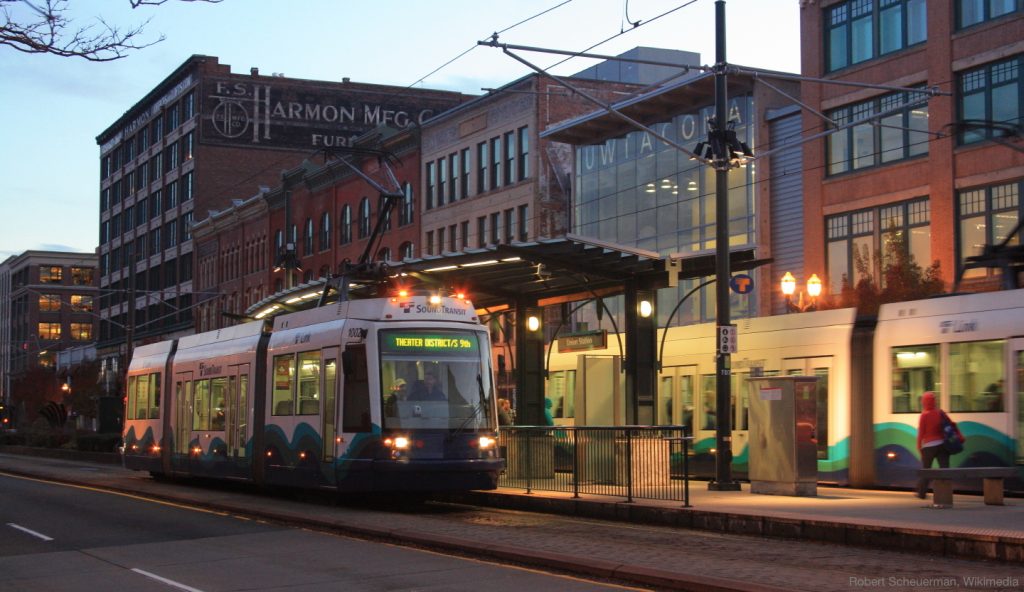
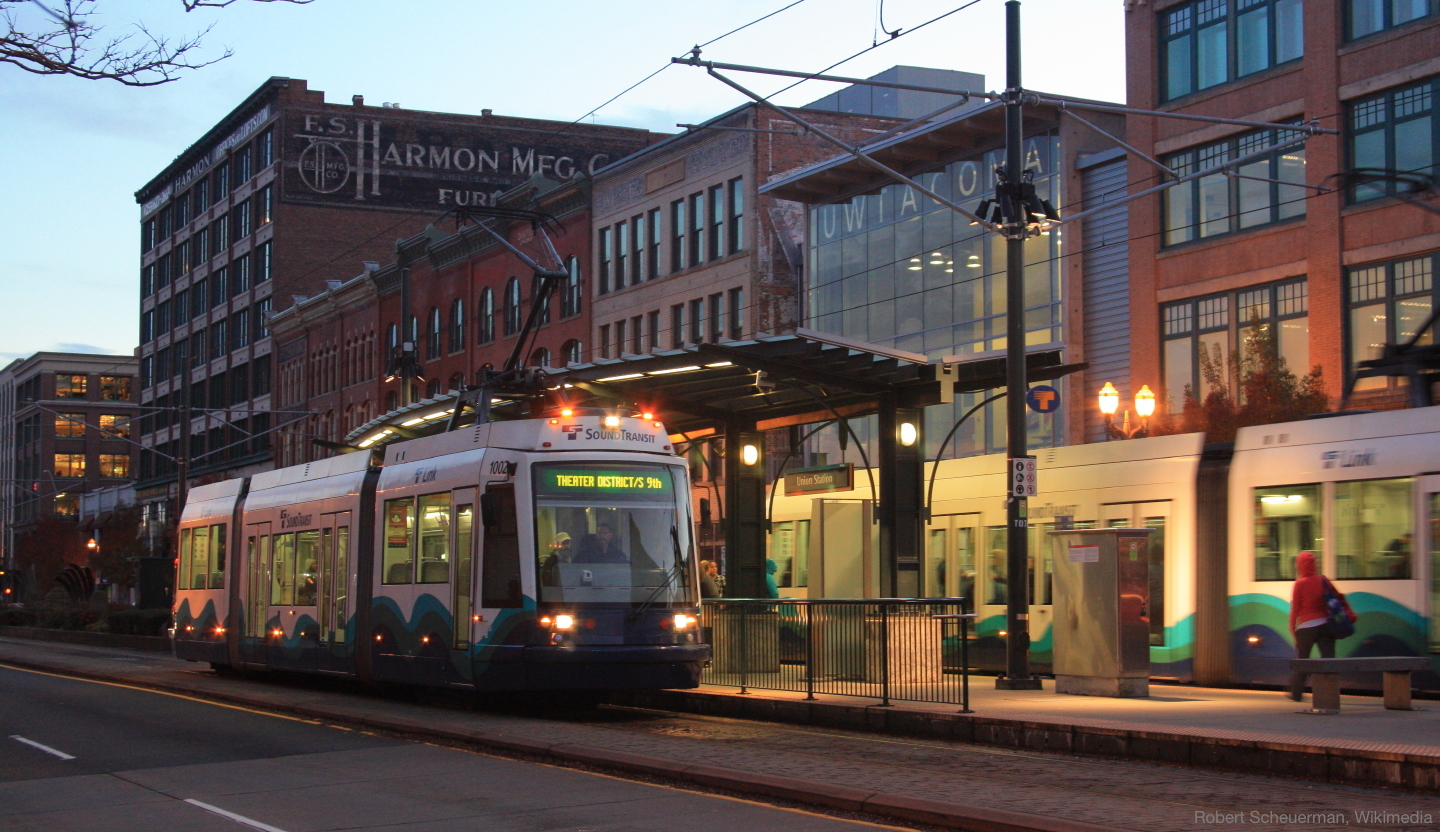
The Trump administration has repeatedly tried to eliminate a critical transit grant program and Congress has repeatedly parried those attempts. The new transportation funding bill from the U.S. House is only the latest evidence that those transit grants are here to stay.
The House of Representatives’ Appropriations Committee recently released a funding bill that covers transportation funding—everything from passenger rail, to highways, to various grant programs like BUILD. One program in particular—the Capital Investment Grant (CIG) program that funds new transit and system expansions—has been a target in this administration’s crusade against transit, as we catalogue in Stuck in the Station.
But despite the administration’s repeated requests to eliminate or cut funding for this program, the new Democratic majority preserved funding for this program—just as the Republicans did when they controlled the House. While there are some proposed changes to the program that help illuminate some of what’s happening behind the scenes, here’s the bottom line:
The administration is still very actively trying to kill the program, Congress is doing as much as they can to ensure the program is executed as intended, and every indication is that this program is here to stay.
Let’s talk funding
All the talk in Washington is about money, so let’s just get this out of the way. Transit grants saw a small ($251 million) decrease over last year’s funding, but that’s only because last year’s was $251 million higher than authorized. So nothing new here.
By our calculations, there are more than enough transit projects making their way through the pipeline that are eager for a slice of this funding. That said, the administration is trying to paint a different picture. By failing to sign new grant agreements, adding additional and unclear requirements, releasing less information publicly, and requesting $0 (or massive cuts) for the program, the Trump administration is trying to undermine this transit funding and discourage local transit agencies from even applying. But Congress has stepped up their oversight of the program to make sure good projects continue to apply and get the funding they deserve.
Congress beefs up oversight
In an attempt to force the U.S. Department of Transportation (USDOT) to actually award grants, sign grant agreements, and fund new transit projects, Congress added unprecedented language last year’s funding bill requiring 80 percent of funding be distributed to projects by the end of 2019. Stuck in the Station tracks USDOT’s progress toward this requirement.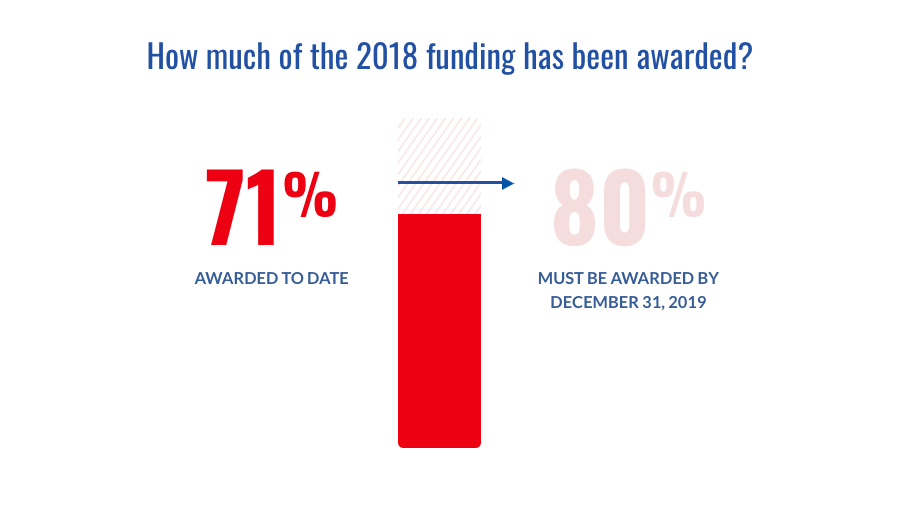
In response, to avoid signing new grant agreements, USDOT has taken the unusual step of doubling awards to projects they’re already obligated to fund to try and hit that mark. And they’ve misled the public about their intentions to sign new grant agreements with some serious verbal gymnastics.
This year, the House has upped the ante. The same 80 percent requirement exists (USDOT will have to distribute 80 percent of this funding by the end of 2020), but any unspent funds would now be automatically awarded to projects in the pipeline, even if the administration has refused to sign a grant agreement. USDOT either needs to do its job and advance these projects or Congress will do it for them.
Federal transit grants aren’t going away
As communities attempt to manage inexorable growth and change, transit investment is critical. Public transportation is and integral part of retaining a talented workforce, attracting businesses and jobs (and getting workers to those jobs), providing affordable transportation and reducing inequities in our communities, reducing greenhouse gas emissions and other dangerous pollutants, improving safety, and reducing congestion.
Undermining federal transit funding doesn’t change those facts; communities are and will continue to invest in transit and the federal government should be a partner in those efforts, not an obstacle. But regardless of USDOT’s actions, there is no indication that grants for new and expanded transit are going anywhere anytime soon. This House appropriations bill is just the latest example.
Repair Priorities Resources
On May 14, Transportation for America released Repair Priorities 2019. Here are all the resources related the report, available to T4A members in one place:
1) Full report
3) A PowerPoint slide deck describing the report’s findings, which you can use in your own presentations. (Member-exclusive resource).
National transportation policy is a rudderless ship sailing off into oblivion
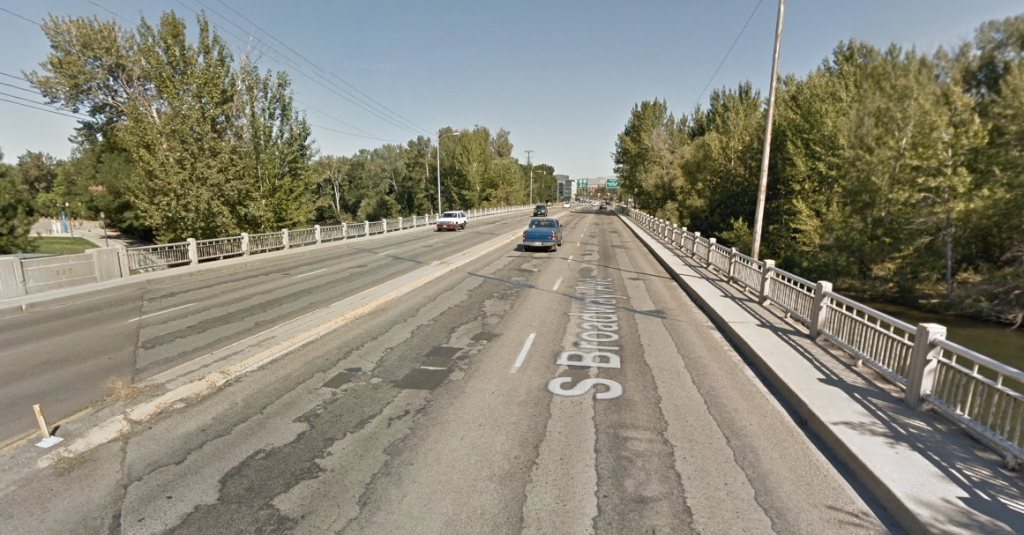
For well over two decades, we’ve had no big-picture guiding purpose for the federal transportation program. Like a ship with a jammed rudder heading off aimlessly into forever, federal transportation policy has been limping along without an overarching purpose or destination in mind. How does this inertia lead us toward all the wrong things?
Is the purpose for the ~$60 billion in federal funds we spend each year merely to increase driving? To add more lane-miles? To ensure that pavement totals increase? To simply build some new stuff and try to keep up with the old stuff? To better connect people with opportunity in a measurable way? Here are six policies embedded in current transportation policy that are not a product of an intentional conversation about what we should accomplish, but rather the result of having zero direction and purpose since we completed the interstate system in 1992.2
1) States are rewarded financially for encouraging more driving and longer trips
It’s no mystery why states spend too much of their money building new lane-miles, new roads, and new bridges at the expense of repair and everything else: The financial payout for states is based on increasing driving as much as possible.
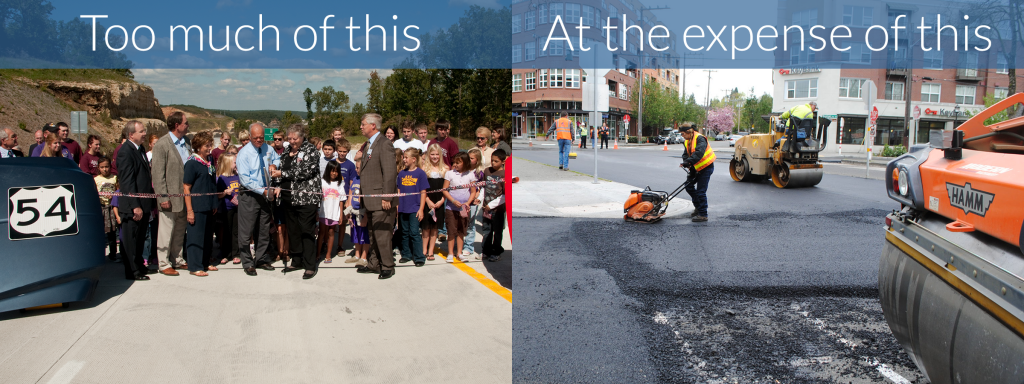
The bulk of all federal transportation money is doled out to states based on a series of formulas tied largely to population, number of lane-miles, and how much everyone drives (vehicle miles traveled, or VMT). If a state encourages more driving or if everyone takes longer trips, that state receives more money the following year. Conversely, if your state finds ways to reduce driving by investing in transit, more logically planning jobs and housing in better proximity to one another, or finding creative ways to manage travel demand, your state loses money.
Put another way, perhaps the most core, embedded philosophy of the federal transportation program is to increase driving—as if more driving itself is an unmitigated economic and societal good.
2) Federal programs originally designed to support and encourage long distance driving are poorly suited to fulfill more complicated modern needs
“Most state departments of transportation were created largely for one reason: to implement a highway-building program,” wrote T4America director Beth Osborne in this series on the Smart Growth America blog, and even the most forward-looking of state DOTs today still have that highway-building DNA embedded deep in their culture. Today’s aimless federal program needs to accomplish far more than the original intended purposes of moving people long distances across states or between metro areas. Yet we still try unsuccessfully to make this old, outdated system serve today’s needs. As Beth wrote in the opener for that series, “the same department that delivered this highway below on the left a few decades ago is the same one tasked with delivering the street on the right, perhaps right in front of your house.”

Our transportation needs have changed, but the federal program has failed to keep up.
3) Transportation emissions are growing because the program is designed that way
Transportation is the #1 sector for emissions and driving represents 83 percent of those emissions. These emissions are rising because people are forced to make more and longer trips. The U.S. has added metro interstate lane miles faster than our metro population has grown, increasing greenhouse gas emissions and obliterating the modest gains made in more efficient vehicles and cleaner fuel. With new roads subsidized by the federal government (covering around 80 percent of the cost), localities struggle to stay ahead of development that spreads further from the center of metro areas, forcing people to travel further to access jobs and services. This leads to a demand for more roads, which induces even more driving and pollution.
We simply can’t continue expanding our roadway network and lower emissions at the same time. The two goals are incompatible, and unfortunately, increasing driving is a purpose embedded deeply in the program. If the main policymakers in Congress can stop talking about money long enough to do so, it’s past time for a conversation about making shorter trips and shared trips a core goal and purpose of the program.
4) We subsidize driving at the expense of providing any other options
Given a transportation challenge to solve, the federal program puts its thumb on the scale in favor of a road “solution” by covering about 80 percent of the cost, while only providing about half of the cost for a transit solution to the same problem. On top of that, not only do we make transit projects jump through more hoops in an arduous development process that no highway projects are subject to, but we actually hold them to a more realistic standard of long-term affordability. As we wrote for Strong Towns last week, “with new federally funded transit projects, agencies have to prove they have sufficient funding to operate and maintain the new line or service, and can do so without shortchanging the rest of their system.”
The federal program encourages costly over-expansion because it doesn’t require states to prove they can afford to maintain what they’ve been encouraged to build in order to get more federal money. Congress is perfectly fine with states building a new road they can’t afford to preserve long-term, even as they are failing to maintain the rest of their system in a good state of repair. And then, as we wrote in Repair Priorities, “those states return to the federal government every few years requesting more funds to address their unmet ‘needs,’ when those needs could have been prevented or delayed with more responsible spending practices.”
That’s why we’re in this goofy situation where every state and every lawmaker seems to thinks the problem is just a lack of money.
5) The program asks the wrong questions and measures the wrong things
The program is obsessed with vehicle speed and you can see it in the few, limited ways that we try to measure whether or not our system succeeds. If you have a 15-minute commute to work in congested urban street traffic, are you better off than if you have a 45-minute commute in traffic that moves quickly? All of the incentives embedded in the program related to how we measure and assess congestion would prefer the second commute. And because free-flowing traffic is considered the gold standard, roads are built to ensure that traffic flows quickly, and this is what leads us to more and wider roads, and more and longer trips. (And streets that are then uninhabitable for anyone walking or biking.) Perhaps, a better measure would be assessing whether or not people can reach jobs and services by any mode of travel, rather than the simplistic measure of whether some of them travel at high speed when driving.
6) We undercut all our other priorities with a strategy to reduce congestion that fails every single time
The federal program is obsessed with reducing congestion, yet everything we do to reduce congestion just makes it worse.
A new study from Cal State Northridge showed that increasing lane-miles increases driving proportionally: a one percent increase in lane-miles results in a one-percent increase in driving. The best part? Expanding roads also fails to improve traffic: the speed increases from highway widenings disappear in five years because of more traffic. We expanded the country’s road system by about three percent from 2009-2017, guaranteeing at least a three percent increase in driving right there. On top of that, it’s impossible to square the priority of speed with the other things we want to accomplish, like improving safety, increasing reliability, or lowering emissions. From the SGA series:
This assumption of “the cars need to always move fast and never slow down” is at the root of most of the big problems that [state DOTs] face. Engineers have a prerequisite—sometimes explicitly stated but always implicit in the agency’s culture of practice—that makes every other priority a nearly impossible task. In practice, what this turns into is a list of secondary goals states would like to accomplish, that usually get sacrificed for the real top priority of speed. Until we come to grips with the fact that moving cars fast at all times of day without delay is a goal that can’t always be squared with all of the other priorities, until we can admit that perhaps everyone is not going to be able to go fast all the time, we’ll continue building unnecessarily large and expensive roads where speed is the number one priority and most other priorities fall by the wayside.
Make sure the vehicles can always go fast |
AND |
|
Wrapping up: It’s past time to make some new goals for what this program is supposed to accomplish
Back in the 1950s we dramatically reshaped our federal transportation policy around accommodating high speed vehicle travel, and our federal program functioned with this unifying purpose for decades. Brand new highways made cross-country and inter-state travel easier than ever before, boosting the national and local economies by connecting places that weren’t well-connected before. But they also started to transform the way we we built homes and destinations by enabling easier travel from cities to their fringes. 3 Today, the challenge is making sure people have access to jobs, services and amenities within easy distance of their homes. To accomplish this, we will need to remove barriers, build bridges (real and metaphorical) and provide safe, affordable convenient alternatives to get around.
Rather than limp along, plowing billions into adding a lane here or a new road there with no equivalent economic return, let’s state a set of clear, explicit goals for the federal program, guaranteeing less driving, more options, healthier communities, and less pollution—all things we should be encouraging as we near the quarter pole of the new century.
House transportation appropriations bill repudiates administration effort to eliminate transit funding
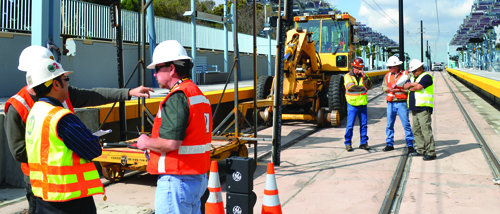
The House took their first step toward approving a transportation funding bill for the next fiscal year (FY20), and it contains mostly good news for transportation, as well as another repudiation of the administration’s attempts to eliminate funds for expanding and improving transit.

The annual Transportation Housing and Urban Development appropriations bill—known as T-HUD—was released yesterday and approved this morning by the House Committee on Appropriations THUD subcommittee. The annual spending bill contains good news for transportation with some programs receiving an increase in funding over last year. It provides solid funding for the transit Capital Investment Grants (CIG) program and the competitive Better Utilizing Investments to Leverage Development (BUILD) grant program. The bill also allocates new resources for research into emerging technologies and prioritizes assistance for vulnerable populations.
T4America worked with Members of Congress to secure a number of policy objectives in this bill, including several important improvements to the BUILD program, changes to the transit capital (CIG) program to encourage FTA to get projects moving, and continued robust funding for several passenger rail programs. T4America members can read a detailed summary below:
[member_content]This member-exclusive memo describes the full details in the Transportation, Housing and Urban Development (THUD) FY 2020 appropriations bill approved by subcommittee. [/member_content]
Transit
The bill rejects the administration’s proposed cut of more than $1 billion and provides the FAST Act authorized level of $2.3 billion for the transit capital program (CIG)— which provides funding for local communities to build major new public transit projects or expand existing service. While this represents a $251 million decrease compared to the amount allocated in 2019, it’s sufficient to meet the obligations to existing projects while also advancing new projects.
The biggest news on this front is that the bill again requires the Federal Transit Administration (FTA) to obligate 80 percent of the allocated funds by the end of the following calendar year (2021) with an aim to force the FTA to advance the deserving projects waiting in the pipeline. Our Stuck in the Station tracker has chronicled how the Trump administration has been slow to spend appropriated dollars through this program. The bill also goes a step further by requiring any unobligated funds (after the 2021 deadline) to be immediately awarded to projects in the pipeline, an effort to prevent the FTA from simply sitting on the money.
The bill also provides $10.8 billion to transit formula programs as authorized by the FAST Act, including funding for bus and bus facilities, no- and low-emission buses, and new competitive grants to assist transit programs in areas of persistent poverty.
BUILD/TIGER
The House bill directs $1 billion to the BUILD program (formerly known as TIGER grant program). As we’ve chronicled, the U.S. Department of Transportation has effectively turned this formerly innovative program, created to advance complex, hard-to-fund projects, into little more than a rural roads program, dramatically undercutting both its intent and utility. The important news here is that several of the reforms T4America proposed for BUILD were included in this House bill:
- Setting aside $15 million for planning grants and requiring the Secretary to award planning grants with an emphasis on transit, transit-oriented development, and multi-modal projects;
- Doubling the maximum award to $50 million;
- Considering the benefits of a project beyond its physical location in an urban or rural area to the fullest extent to include all relevant geographic areas.
In addition, the House bill also sets aside $20 million within BUILD for the planning, preparation or design of projects in areas of persistent poverty.
Passenger rail
The House bill continues to provide support for many important programs which fund existing and expanded passenger rail service. Funding for Amtrak’s Northeast Corridor increased by $50 million over FY19 while the national network is funded at $1.291 billion, the same level as FY19.
The news was mixed for the two programs that provide the bulk of competitive capital grants and operating support to improve service, upgrade old equipment, and grow passenger rail service nationwide. The Consolidated Rail Infrastructure and Safety Improvement (CRISI) Grants Program is funded at $350 million, $20 million more than the FAST Act authorized level, and includes a new set aside ($55 million) for “the acquisition of rights of-way, track, or track structure” to support the development of new intercity passenger rail service routes. Unfortunately, the bill doesn’t provide any funding for the Restoration and Enhancement Grants (R&E) program, which was authorized to receive $20 million each each under the FAST Act. We’re hoping the Senate bill will recognize the importance of these programs and provide funding to the R&E program.
What’s next for 2020 appropriations?
With the subcommittee markup wrapped up now, it is expected to be considered by the full Appropriations Committee in the coming weeks and then the full House by the end of June. The Senate has yet to introduce its version of this bill, but we expect that to happen sometime in the next few weeks. T4America will continue keeping a close watch as the critical annual FY20 spending bill progresses.
Key programs
In millions of dollars
| Funds by program | FY18 enacted | FY19 enacted | President’s FY20 budget | House FY20 appropriations |
| Formula funds (Mass Transit Account) | $9,733 | $9,900 | $9,940 | $10,800 |
| Capital Investment Grants | $2,600 | $2,552 | $1,046 | $2,301 |
| BUILD (formerly TIGER) | $1,500 | $900 | $0 | $1,000 |
| Amtrak (Northeast Corridor) | $650 | $650 | $200 | $700 |
| Amtrak (national network) | $1,292 | $1,291 | $538 | $1,291 |
| Federal-State Partnership for State of Good Repair | $250 | $400 | $0 | $350 |
| Consolidated Rail Infrastructure & Safety Improvement Grants | $593 | $255 | $0 | $350 |
| Restoration & Enhancement Grants | $20 | $5 | $0 | $0 |
Policy Memo: FY20 THUD House Bill
On May 22, the House Appropriations Committee subcommittee on Transportation, Housing and Urban Development (THUD) released its fiscal year 2020 (FY20) appropriations bill. This member-exclusive memo describes the bill.
The inside scoop on Repair Priorities 2019

After the release of Repair Priorities 2019, we hosted a webinar in partnership with Taxpayers for Common Sense to talk about the findings and recommendations of our new report. During the webinar we heard from our own Director of Transportation for America, Beth Osborne, and Steve Ellis, Executive Vice President of Taxpayers for Common Sense, about why we need reevaluate our federal transportation policy (which governs how we spend money) before dumping more money into the same broken system.
We were also joined by two speakers from state DOTs working to prioritize repair with available funding. Jack Moran, Deputy Chief of Performance and Asset Management for the Massachusetts DOT, talked through the nitty-gritty of how MassDOT has set up a state transportation program that puts repair needs first and demonstrates accountability to the public. Dick Hall, Chairman of the Mississippi Transportation Commission, spoke about why and how Mississippi DOT has made a recent dramatic shift away from road expansion toward repair, including making a difficult decision to halt expansion projects already in the pipeline.
Watch the recorded webinar below and download your copy of Repair Priorities 2019.
Other related resources:
Forget the infrastructure plan — we don’t need it.
In a pointed opinion piece published by the Washington Post, Transportation for America Director Beth Osborne made the case for focusing on federal policy reform instead of a one-time infusion of more funding into a yet-to-be-defined infrastructure plan.
How to build a better state DOT
Smart Growth America took a long look at how current practices and policies at state departments of transportation (DOTs) lead to the construction of huge, expensive road projects (i.e. highways) as a ‘solution’ to almost every transportation problem and how they can do better. Governing Magazine also published a piece on the work with state DOTs that includes interviews with Beth Osborne and Washington State DOT Secretary Roger Millar.
Local business groups fight for public transit
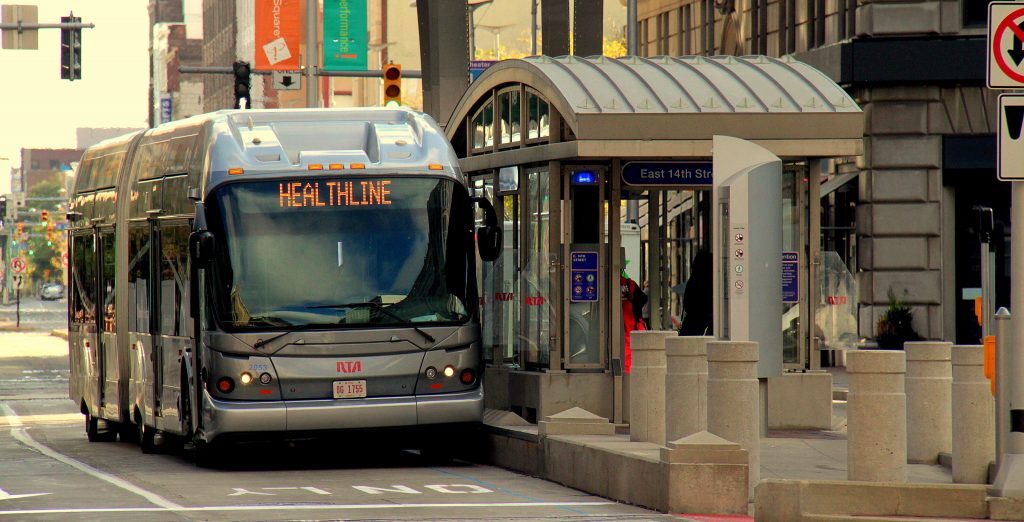
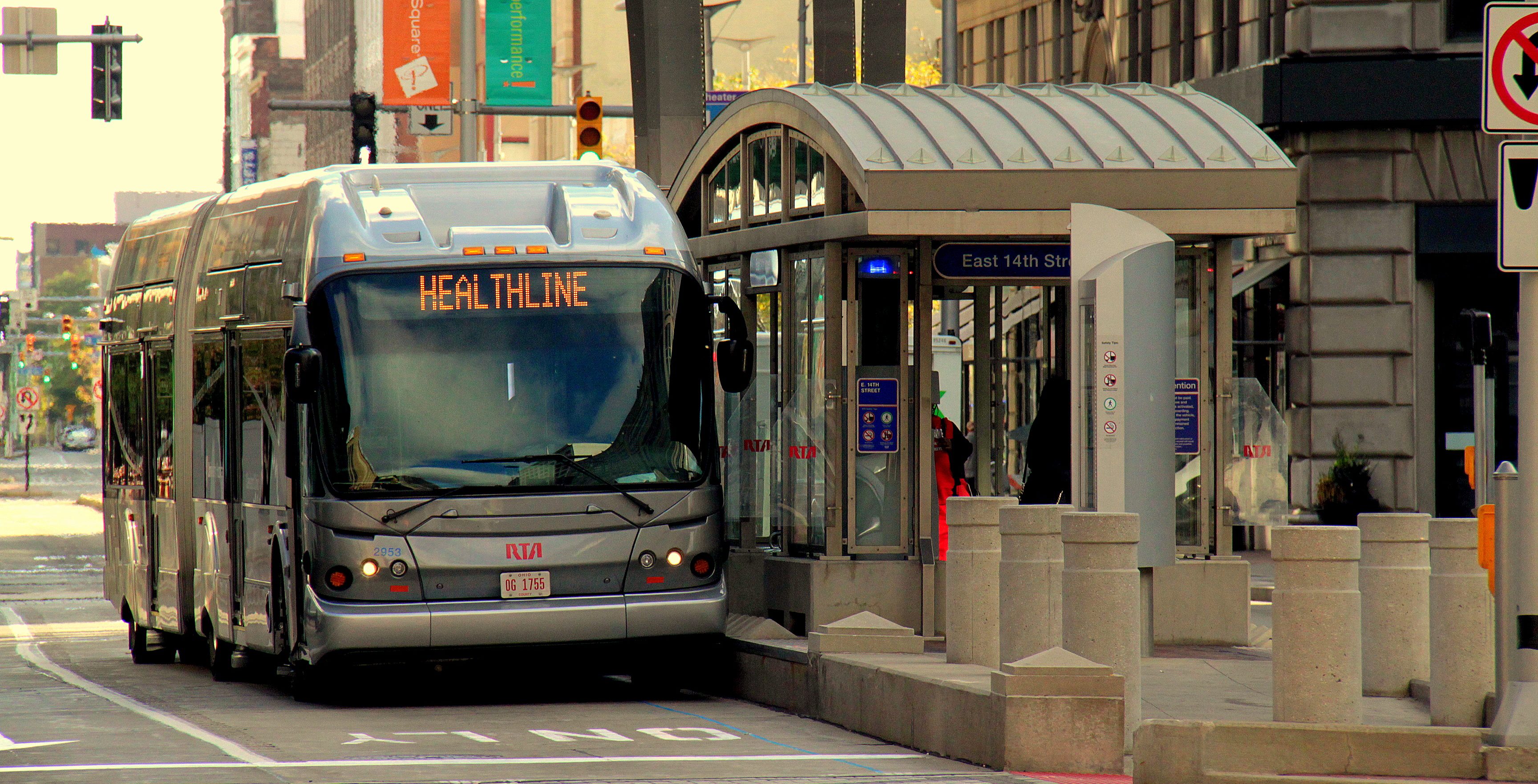
Twenty-five chambers of commerce and other organizations representing local business interests across the country have formed Chambers for Transit, a coalition facilitated by Transportation for America to fight for more federal support for transit.
The importance of robust public transit for local economies is clear. Core Values: Why American Companies are Moving Downtown showed that walkability and transit access were key to attracting businesses and talent in 2015. The Amazon HQ2 search was just the latest example: “access to mass transit” was one of the core preferences in Amazon’s request for proposals. From Kansas City where the business community rallied around the downtown streetcar to Indianapolis where the business community led the effort to build out a network of bus rapid transit lines, local business groups are keenly aware of how important transit is to economic success.
“I believe transit is a powerful catalyst for inclusion, connecting people to employment, education, and daily necessities,” said Mark Fisher, Chief Policy Officer of the Indy Chamber. “And it’s not just helping people leave their neighborhoods for these things, but bringing new investment to the areas that desperately need it. Knowing that transit means empowerment for my neighbors across Indianapolis is a daily motivation.”
However, many in Washington, DC haven’t gotten the memo. The Trump administration proposed eliminating funding for transit grants in its first two budgets. This year, President Trump proposed a draconian, $1 billion cut in his budget instead. While Congress has so far rejected those requests, it remains to be seen whether legislators will give transit a more equitable split of overall federal transportation funding as they draft long-term federal transportation policy (current policy expires in September 2020).
 That’s why Transportation for America is bringing the voices of local business groups that are clamoring for transit investment to lawmakers on Capitol Hill. These groups understand that transit is critical to improve access to jobs, spark new development, and create the kinds of vibrant communities that can attract a talented workforce.
That’s why Transportation for America is bringing the voices of local business groups that are clamoring for transit investment to lawmakers on Capitol Hill. These groups understand that transit is critical to improve access to jobs, spark new development, and create the kinds of vibrant communities that can attract a talented workforce.
Congress should fully fund federal transit programs and strengthen its role supporting transit in the coming reauthorization. Chambers for Transit will bring that message to Washington.
“As Utah’s population continues to grow, transit is more important than ever,” said Derek Miller, President & CEO of the Salt Lake Chamber. “The availability of high quality transit in our communities directly correlates with Utah’s economic success, business-friendly climate and high quality of life.”
Visit the Chambers for Transit page to learn more and see which organizations are all aboard for more public transportation.
In the Washington Post: Let’s skip the infrastructure spending spree

 A new opinion piece in the Washington Post takes a contrarian view of all the talk about money during Infrastructure Week. Let’s skip the infrastructure plan and focus on policy, because without good policy more spending could actually do more harm than good.
A new opinion piece in the Washington Post takes a contrarian view of all the talk about money during Infrastructure Week. Let’s skip the infrastructure plan and focus on policy, because without good policy more spending could actually do more harm than good.
Yesterday, Repair Priorities 2019 showed how America desperately needs to change federal transportation policy that allows states to neglect their repair needs in favor of costly road expansions.
Today, a new piece in the Washington Post from Transportation for America Director Beth Osborne makes that clear with some pointed language:
At best, this infrastructure plan would throw more money into the same flawed system. At worst, Congress and the president would be signing a blank check with no sense of what the money is intended to accomplish, no clear system for accountability, no requirements for states to actually repair our “crumbling roads and bridges” and no guarantees that any of us would have an easier time getting from A to B when all that money has been spent.
What we need from Congress is an update to federal transportation policy for the next six years, which governs how we spend some $61 billion annually on highways and transit programs. And we need lawmakers to find more than $13 billion a year to cover shrinking gas-tax revenue.
Share on Twitter Share on Facebook
Agencies competing for limited federal funds to expand transit must prove they can also cover long-term maintenance and operations, something no road project ever has to do. When state highway departments can’t cover their commitments because they’ve prioritized expansion over repair, they’ll just ask for more money.
After all, there will always be another Infrastructure Week.
While decision makers are focused on infrastructure this week, so are we. Read the full op-ed and then share Beth’s message with your networks on Twitter and/or Facebook to help us spread the word!
Repair Priorities 2019 is here — and it shows that more money won’t fix our infrastructure problems
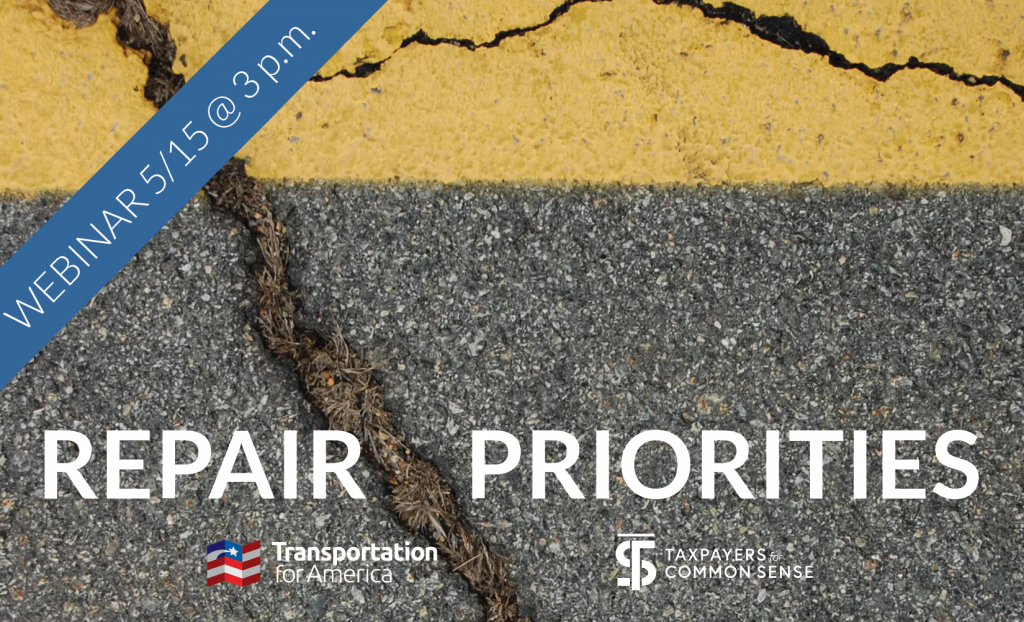
It’s infrastructure Week again and politicians are back at it, bemoaning our “crumbling roads and bridges” and insisting we must spend more to fix the problem. But we’ve got some cold water to throw on this pity party: Despite more transportation spending over the last decade, the percentage of the roads nationwide in “poor condition” increased from 14 to 20 percent.

That’s the headline from our new report—Repair Priorities 2019—which finds that states are neglecting repair and routine maintenance in favor of costly expansions and widenings. Even when given more flexibility by Congress to spend money as they see fit, states, on average, spent as much money expanding their road networks ($21.3 billion) as they did repairing their existing roads ($21.4 billion) each year.
In short, our infrastructure issues are more of a policy problem than a money problem.
As T4America Director Beth Osborne said in our release today, “While a handful of states are doing an admirable job putting their money where their mouth is by devoting the bulk of their federal dollars to repair, many other states are spending vastly more on expanding their roads or building new ones—creating new liabilities in the process—even as their existing system falls into disrepair.”
Download Repair Priorities for a state-by-state look at how states are spending their money and what it will take to fix the system. Then join us for awebinar on Wednesday May 15 at 3 p.m. ET/12 p.m. PT to hear from two state DOT officials about the findings.
Putting the (money) cart before the horse
Two trillion is the hottest number in Washington right now—it’s how much money politicians want to pump into a yet-to-be-fleshed-out infrastructure plan. Although they haven’t yet articulated what all that extra spending will actually achieve or how this money will be spent more responsibly than the hundreds of billions we spent over the last decade, they already know the price tag.
We need to #BuildForTomorrow, they say. We have a question: Build WHAT for tomorrow?
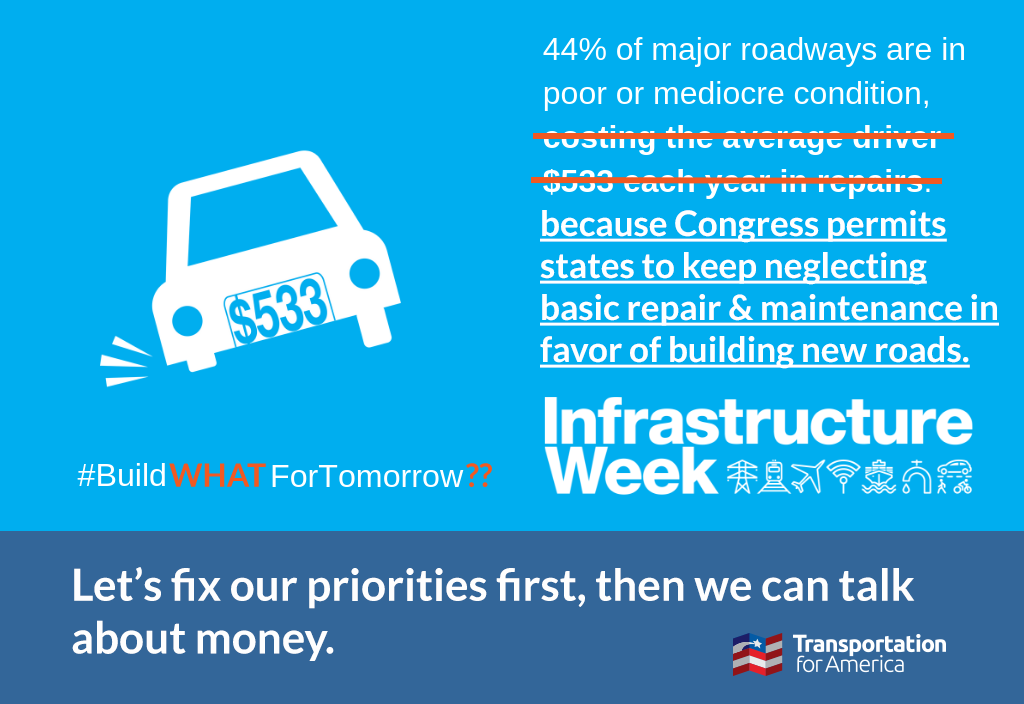
The scope of our vision and ambition should determine how much money we need to spend on infrastructure. And that vision should then be supported with thoughtful policy—not a blank check—that will make sure we achieve our goals.
Getting back on track
So what might thoughtful policy look like? For starters, we should give taxpayers an idea of what they’re paying for with clear, measurable outcomes—do we want to cut the number of roads in poor condition in half over the next six years? Reduce traffic fatalities by 60 percent? Decrease emissions by 70 percent? Define the vision and set some measurable goals first.
We could require states to use available federal funding—billions of dollars they’re given automatically every year—to fix the system before expanding it. We could establish a competitive funding program for new road capacity that requires a higher standard for asset management—just like we do for transit. We could require more frequent and diligent reporting so that taxpayers can hold their officials accountable.
What do all these ideas have in common? They’re about policy not money. Whether it’s a stand-alone infrastructure bill or our existing federal transportation program, policy is the key to fixing America’s infrastructure problem. It’s about time the policy makers took that to heart.
Download Repair Priorities 2019New report chronicles how the nation’s road conditions have worsened as many states prioritize expansion instead of repair

Report comes as the White House and congressional leaders continue discussing a $2 trillion infrastructure package that could exacerbate the problem
WASHINGTON, DC — Repair Priorities 2019, a new report released today by Transportation for America and Taxpayers for Common Sense, shows that, despite more spending, the percentage of the roads nationwide in “poor condition” increased from 14 percent to 20 percent and 37 states saw the percentage of their roads in poor condition increase from 2009-2017.
This is happening because states are neglecting basic repair in favor of expanding their roads. Given increasing spending flexibility by Congress over the last two long-term transportation reauthorizations, states spent nearly as much money expanding their road networks as they did repairing their existing roads ($120 billion spent building new lane-miles from 2009 to 2014).
“Whether during debate over an infrastructure bill or the long-term reauthorization looming next year, the rhetoric I hear over and over again from Capitol Hill and the White House about the need to invest more money in transportation is all about ‘repairing our crumbling roads and bridges.’ But our spending priorities rarely match this oft-repeated rhetoric,” said Beth Osborne, director of Transportation for America.
“A look at the numbers from the Federal Highway Administration in Repair Priorities makes it clear that we can scarcely afford to maintain the roads we have, let alone the new roads we keep adding to the system. While a handful of states are doing an admirable job putting their money where their mouth is by devoting the bulk of their federal dollars to repair, many other states are spending vastly more on expanding their roads or building new ones— creating new liabilities in the process—even as their existing system falls into disrepair.”
“Lawmakers and officials like a good ribbon cutting at a new road, but repair is too often treated like flossing teeth: A tedious, sometimes painful extra step that’s all too easily skipped. Except that it’s critical and saves taxpayers cash and pain down the road,” said Steve Ellis, executive vice president of Taxpayers for Common Sense. “Instead of sending blank checks to the states, federal taxpayers deserve to have some assurances that their tax dollars will be spent effectively and efficiently on the highest priority projects, which in most cases is taking care of what we already have.”
It’s unclear if we could even afford to maintain all the roads that we’ve built, even if we devoted all available capital dollars toward repair. Repair Priorities estimates that we would need to spend more than $231 billion per year just to keep our existing road network in acceptable repair and bring the backlog of roads in poor condition into good repair over a six-year period (the typical length of a federal transportation reauthorization). By comparison, all highway capital expenditures across all government units in 2015 totaled just $105.4 billion, only a portion of which goes to repair.
The latest available data shows states have made some improvement in their spending since the first edition of Repair Priorities in 2011, but states are still spending just as much on road expansion as road repair. States spent $21.4 billion on average on road repair annually between 2009-2014 and $21.3 billion annually on road expansion.
When states devote money to expanding their roads, it doesn’t just redirect funds away from repair and maintenance; it also continually expands our overall annual spending need. We built enough new lane miles from 2009-2017 to criss-cross the width of America 83 times, requiring an additional $5 billion per year just to keep those new roads in good condition. That’s more than Tennessee, Mississippi, Alabama, Georgia, Louisiana, and Arkansas receive combined in federal highway apportionments every single year.
So what will it take to fix the system? Transportation for America and Taxpayers for Common Sense provide four concrete recommendations for Congress to consider in any infrastructure package they consider, including the upcoming 2020 federal transportation bill. Congress should: guarantee measurable outcomes for American taxpayers with any new funding, require that states repair their existing systems before expanding, require project sponsors to demonstrate that they can afford to maintain new roadway capacity projects, and track progress and require that FHWA publish results.
Repair Priorities 2019 provides a national snapshot and state-by-state evaluation of current roadway pavement conditions, spending trends, and unmet needs. It also recommends crucial actions federal policymakers should take in the next transportation reauthorization bill to get the nation’s roads—and spending priorities—back on track.
The full report and state-by-state findings are available at https://t4america.org/maps-tools/repair-priorities
###
Transportation for America, a program of Smart Growth America, is an alliance of elected, business, and civic leaders from communities across the country, united to ensure that states and the federal government step up to invest in smart, homegrown, locally-driven transportation solutions. These are the investments that hold the key to our future economic prosperity.
Smart Growth America envisions a country where no matter where you live, or who you are, you can enjoy living in a place that is healthy, prosperous, and resilient. We empower communities through technical assistance, advocacy, and thought leadership to realize our vision of livable places, healthy people, and shared prosperity.
Taxpayers for Common Sense is an independent, nonpartisan voice for taxpayers working to ensure that taxpayer dollars are spent responsibly and that government operates within its means.
Did you know that it’s Infrastructure Week once again?
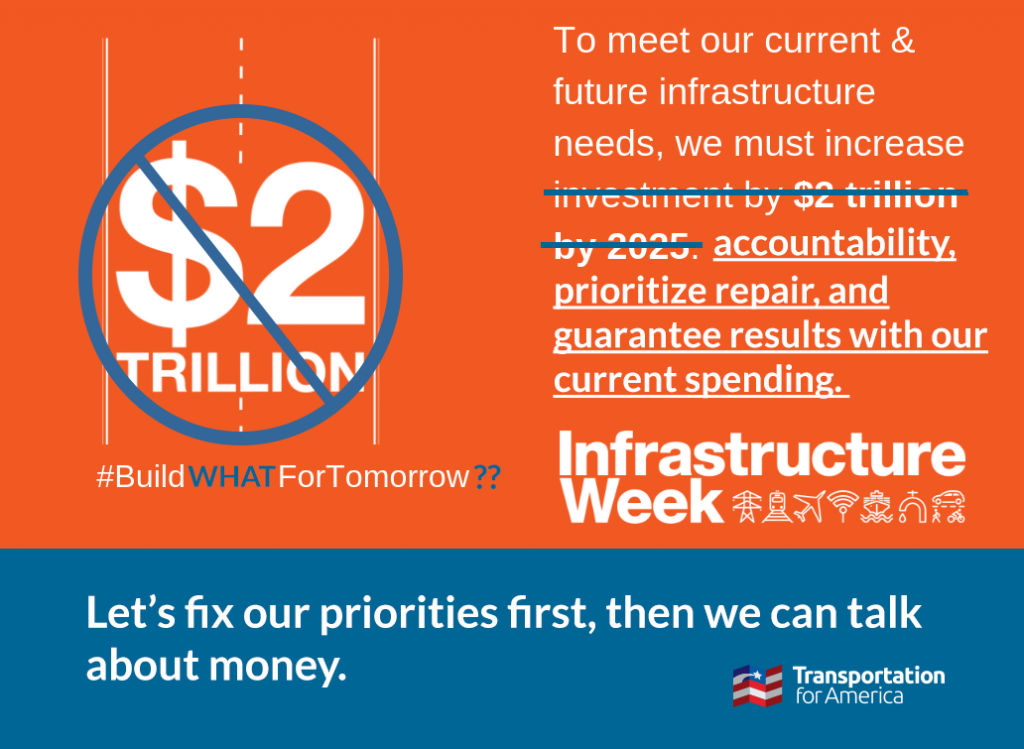
After two solid years of everyone in Washington, DC talking nonstop about a standalone infrastructure bill to pump trillions into America’s infrastructure, we’d understand if you weren’t aware that the last Infrastructure Week ever ended.
If you haven’t seen the evidence in your inbox already, the incessant drumbeat for more money is already underway today. All this week, you’ll hear the usual interest groups starting this conversation by talking about nothing but money:
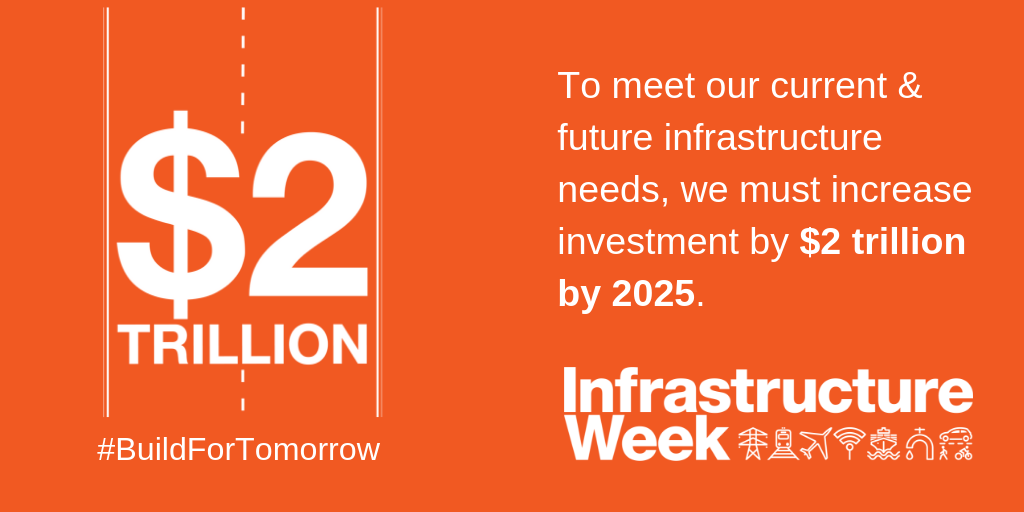
Why are they telling us the price before they’ve told us what we’re buying?
We think that this is backwards, and our Repair Priorities 2019 report, launching tomorrow, will help show why. Even as we gave states more than $300 billion to spend almost however they wanted to—in addition to billions more in the 2009 stimulus—the condition of our nation’s roads actually got worse from 2009-2017. Thirty-seven states saw an increase of roads in “poor” condition.
Our roads got worse not because we lacked money, but because too many states spent that money on building or expanding new roads rather than being good stewards by prioritizing repair. We built enough new lane-miles during that period to criss-cross the country 83 times, roads that will cost us $5 billion more per year just to maintain in good condition.
This is more than a money problem—it’s a priorities problem.
Congress has to stop asking taxpayers for more funding to fix crumbling roads and bridges without providing concrete, measurable assurances that any new money will actually improve things.
The public deserves to know first what more money is going to buy us—not just how much money they “need.” Congress’ decisions over the last two decades has just led to a lack of transportation options, more inequality, and more and bigger roads filled with more traffic and more pollution.
If you think we need to fix our spending priorities before we even think about pouring more money into this broken system, then bypass the Infrastructure Week rhetoric and share our social media message for Monday instead:
Today is the 1st day of #InfrastructureWeek. Why in the world would we give more money to the same people who have been neglecting basic maintenance in order to build more things we can’t afford to maintain? #BuildWHATForTomorrow?”

Repair Priorities 2019 is being released tomorrow. Sign up for Wednesday’s 3:00 p.m. EDT webinar examining the findings now.
REGISTER NOW




